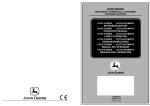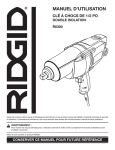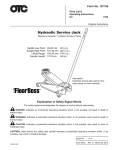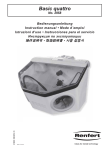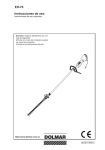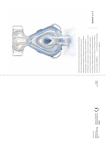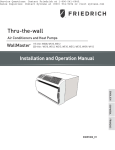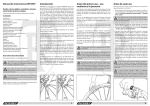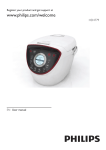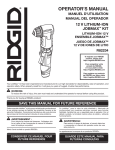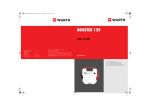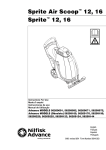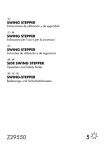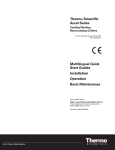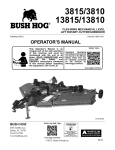Download USE AND MAINTENANCE USO E MANUTENZIONE USO Y
Transcript
02252 EDIZIONE 2009 USE AND MAINTENANCE USO E MANUTENZIONE USO Y MANTENIMIENTO INDEX / INDICE / INDICE GB Safety regulations..................................................................................................................p. GRILLO CLIMBER hydrostatic grass cutter/lawn mower ......................................................p. Identification and technical assistance ..................................................................................p. Technical data........................................................................................................................p. Instructions for use ................................................................................................................p. Maintenance and lubrication..................................................................................................p. Trouble-shooting....................................................................................................................p. Control description.................................................................................................................p. Noise and vibration levels......................................................................................................p. 3 9 11 12 13 14 17 39 47 I Norme antinfortunistiche........................................................................................................p. Trinciaerba/rasaerba idrostatico GRILLO CLIMBER.............................................................p. Identificazione e assistenza...................................................................................................p. Caratteristiche tecniche .........................................................................................................p. Istruzioni d’uso.......................................................................................................................p. Manutenzione e lubrificazione ...............................................................................................p. Guida all’identificazione degli inconvenienti ..........................................................................p. Descrizione dei comandi .......................................................................................................p. Rumorosità - vibrazioni .........................................................................................................p. 3 19 21 22 23 24 27 39 47 SP Normas para prevención de accidentes ................................................................................p. Desbrozadora/cortadora de césped hidrostática GRILLO CLIMBER....................................p. Identificación y asistencia......................................................................................................p. Características técnicas ........................................................................................................p. Instrucciones de uso..............................................................................................................p. Mantenimiento y lubricación ..................................................................................................p. Guía a la identifcación de los inconvenientes .......................................................................p. Descripción de los mandos ...................................................................................................p. Niveles del ruído - vibración ..................................................................................................p. 3 29 31 32 33 34 37 39 47 3 BEWARE! This machine has been manufactured to european standards and carries the GENERAL SECURITY RULES mark. ATTENZIONE! Questa macchina è costruita secondo le normative europee ed è certificata col marchio NORME DI CARATTERE GENERALE SULLA SICUREZZA . ATTENTION! Cette machine est fabriquée selon les directives européennes et est certifiée par le label RÈGLES GÉNÉRALES DE SÉCURITÉ . ACHTUNG! Diese Maschine entspricht den europäischen Richtlinien und ist mit dem ALLGEMEINE SICHERHEITSREGELN Zeichen zertifiziert. ¡ATENCIÓN! Esta máquina es fabricada según las normas europeas y es certificada con la marca NORMAS DE CARÁCTER GENERAL SOBRE LA SEGURIDAD . ATENÇÃO! Esta máquina foi construída em conformidade com as normas europeas e está certificada com a marca NORMAS DE CARÁCTER GENERAL ACERCA DA SEGURANÇA . Read the manual before starting up and moving the machine. Leggere questo manuale prima di avviare e mettere in movimento la macchina. Lire ce livret avec attention avant de mettre en marche le moteur et de faire démarrer la machine. Vor der Inbetriebnahme der Maschine dieses Handbuch sorgfältig durchlesen. Leer este manual antes de encender y poner en movimiento la máquina. Leia atentemente este manual antes de accionar e pôr a máquina em movimento. Take special care not to touch hot parts of the engine. Prestate particolare attenzione a non entrare in contatto con parti surriscaldate del motore. Veiller tout particulièrement à ne pas toucher des éléments surchauffés du moteur. Achtung – keine heißen Motorteile berühren! No tocar partes recalentadas del motor. Tome muito cuidado para não entrar em contacto com as partes aquecidas do motor. 4 Auspuffgase können Übelkeit oder Tod verursachen. Wenn es notwending ist, einen Motor in einem geschlossenen Raum laufen zu lassen, benützen Sie eine Verlängerung, um das Auspuffgas abzuleiten. Versuchen Sie immer in einem ventilierten Raum zu arbeiten. La séparation entre le pneu et la jante, provoquée par l’explosion d’une roue peut causer des dommages, blessures ou la mort. Die Trennung der Räder von den Felgen durch Explosion kann schwere Verletzungen oder den Tod verursachen. Sharp component. Keep hands and feet away. Do not clean the attachment when the engine is turning. 5 Prevent battery explosions: keep sparks, lighted matches and open flames away from the top of the battery. Battery gas can explode. Per prevenire l’esplosione della batteria, tenete scintille, fiammiferi accesi e fiamme lontani dalla stessa. Il gas della batteria può esplodere. Prevenir l’explosion de la batterie: tenir les éticelles, les alumettes et le feu loin de la batterie. Le gaz de la batterie peut exploser. Vorbeugung der Batterie-Explosion. Entfernen Sie Funken, Zündhölzer und Flammen von der Batterie. Das Batteriegas kann explodieren. Para prevenir la explosión de la batería, mantener chispas, cerillas encendidas y llamas lejos de la misma. El gas de la batería puede explotar. Para prevenir explosao da bateria ter centelhas, fosforos acendido e chamas longe da mesma.O gas da bateria poderia expludir. Sulfuric acid in battery electrolyte is poisonous. It is strong enough to burn skin, eat holes in clothing and cause blindness if it gets in contact with the eyes. L’acido sulfureo della batteria è velenoso. È in grado di causare bruciature alla pelle, bucare vestiti e causare cecità se arriva negli occhi. L’acide sulfurique de la batterie est toxique. Il peut causer des brûlures à la peau, endommager les vêtements et peut aussi causer cécité. Säure der Batterie ist giftig. Sie kann die Haut verbrennen, Löcher in die Kleidung machen und Blindheit verursachen. El ácido sulfúreo de la batería es venenoso, puede provocar quemaduras en la piel, agujear la ropa y provocar ceguez si llega a los ojos. O acido sulfurico e toxico. Pode ser causa de queimadura da pele, furar roupa e provocar cegueira, no caso chegarem em contacto com os olhos. Avoid tipping. Do not drive where machine could slip or tip. Stay alert for holes and other hidden objects. Evitate le scivolate. Non guidate dove la macchina potrebbe scivolare o inclinarsi. Attenzione a buche o ad oggetti nascosti. Eviter les pentes. Ne pas conduire la machine où elle peurrait glisser ou se renverser. Faire attention aux trous ou à tout autre obstacle caché. Nicht dort fahren, wo die Maschine rutschen könnte. Vorsicht bei Löchern oder versteckten Gegenständen. Evitar patinazos. No conducir donde la máquina pueda patinar o inclinarse. Cuidado con los baches o con objetos escondidos. Evitar deslizamentos. Nao diriga em lugares onde a maquina poderia deslizar. Ter cuidado a buracos e objetos escondidos. Rotating blades are dangerous. Protect children and prevent accidents. Le lame in movimento sono pericolose. Proteggete i bambini e prevenite gli incidenti. Les lames en rotation sont dangereuses. Proteger les enfants et prévenir les accidents. Arbeitende Messer sind gefährlich, Kinder schützen und Unfälle vorbeugen. Las cuchillas en movimiento son peligrosas, proteger a los niños y prevenir los accidentes. As facas em movimento sao perigosas.Proteger as criancas e prevenir acidentes. 6 WARNING! SHARP PARTS. Keep hands and feet away. Do not operate the mower over gravel or foreign bodies which may be sucked up and ejected by the blades, generating a danger. Keep people away. Remove the key and read the instruction manual before attempting to carry out any maintenance or repairs to the machine. ATTENZIONE! ORGANO TAGLIENTE. Tenere lontano mani e piedi. Non lavorare col rasaerba sopra alla ghiaia o corpi estranei che possono essere aspirati e centrifugati dalle lame risultando molto pericolosi, tenere lontano le persone. Togliere la chiave e leggere le istruzioni prima di effettuare qualsiasi operazione di manutenzione e riparazione. ATTENTION! ORGANE TRANCHANT. Eloigner les mains et les pieds. Ne pas utiliser la tondeuse sur le gravier ou sur des corps qui peuvent être aspirés et centrifugés par les lames et devenir très dangereux. Les personnes doivent se trouver à une certaine distance. Enlever la clé et lire les instructions avant toute operation de maintenance et de réparation. ACHTUNG! SCHARFE KLINGEN. Hände und Füße fernhalten. Beim Mähen nicht über Schotter, Steine oder andere Fremdkörper fahren, da diese durch die Drehbewegung der Messer angesaugt und weggeschleudert werden können (Verletzungsgefahr). Nicht in der Nähe von anderen Personen mähen. Vor jedem Wartungs- bzw. Reparatureingriff den Startschlüssel abziehen und die Gebrauchsanleitung durchlesen. ¡PELIGRO! ÓRGANO CORTANTE. Mantener lejos los pies y las manos. No limpiar la herramienta con el motor en marcha. ¡Peligro! Expulsión de objetos: mantener alejadas las personas. Atención: quitar la llave y leer las instrucciones antes de efectuar cualquier operación de mantenimiento o reparación. ATENÇÃO! Órgão cortante. Ficar longe com pés e maos. Nao trabalhar com a máquina sobre cascalho ou objetos que poden ser aspirados e centrifugados gerando perigo, manterse longe das pessoas. Tirar a chave de ignicao e ler as istrucoes antes de efetuar qualquer operacao de reparo ou servico. DANGER! Machine rollover: Do not use this machine on slopes greater then 17°. PERICOLO! Ribaltamento della macchina: Non usare questa macchina su pendii superiori ai 17°. DANGER! Renversement de la machine: Ne pas utiliser cette machine sur des pentes supérieures à 17°. GEFAHR! Umstürzen der Maschine: MAX 17° Die Maschine nicht an Hängen mit einer Neigung über 17° einsetzen. ¡PELIGRO! Volcado de la máquina: No utilizar esta máquina en pendientes superiores a 17°. 7 1 2 3 4 8 “GRILLO CLIMBER” HYDROSTATIC GRASS CUTTER / LAWN MOWER Dear Customer, thank you for choosing the Grillo CLIMBER. We hope that this new tractor mower will perfectly meet your requirements. For best use and maintenance over time, please carefully read and follow the instructions given in this manual. This will enable you to get top results from your mower and will prevent avoidable expense. Please look after this manual which should always be kept with the machine. WARNING! Read carefully before starting the engine. These instructions are vital to avoid accidents! SAFETY RULES Caution is the best tool for accident prevention. Your are urged to read the following instructions for use of the mower before starting work. Incorrect use of the mower and its equipment may cause damage. To reduce this risk, follow the precautions given below: 1) Read the whole of this manual before starting up the mower and setting it into motion. 2) Pay particular attention to the warnings and safety labels on the mower. 3) The rotating blades of the mower are highly dangerous. Never place your hands or feet under the mower. 4) Before allowing others to use the mower, inform them of the safety rules and carefully instruct them on how to use the machine. 5) Before starting up the mower, make sure that there is nobody nearby, and particularly that there are no children in the vicinity. 6) Before starting to reverse the mower, make sure that there is nobody and no obstacles behind. 7) Do not allow passengers on the mower. 8) Never use the mower if you are tired, and do not use after drinking alcohol. 9) Check the land before starting mowing. Make sure that there are no stones, sticks or other foreign bodies that may damage the machine or be thrown a long way, creating a danger to anybody in the vicinity. 10) Before starting work, put on suitable working clothes, gloves, strong shoes and protective glasses. 11) Before getting off the mower, turn off the engine, turn off the PTO and remove the ignition key. 12) This machine cannot be driven on public roads. 13) Travel at low speed along rough tracks. 14) Reduce speed when travelling down steep slopes. 15) Do not allow children to operate the machine: use is prohibited under the age of 16. 16) Do not reverse at high speed. 17) It is dangerous to move the steering wheel abruptly when the engine is running at top speed. 18) While working, never operate the start and reverse pedals abruptly. 19) To avoid the danger of inhaling toxic fumes, do not turn on the engine in closed areas. %HIRUHVWDUWLQJWKHHQJLQHÀOOXSWKHWDQNZLWKIXHO $OZD\VWXUQRIIWKHHQJLQHEHIRUHÀOOLQJXSZLWKIXHO.HHSDZD\IURPVSDUNVDQGQDNHGÁDPHVDQG do not smoke! Do not remove the fuel tank cap when engine is hot. Replace the fuel and container cap securely. 9 'RQRWDOORZWKHIXHOWRRYHUÁRZ$IWHUÀOOLQJWKHWDQNFOHDQRIIDQ\VSLOOVRQWKHPRZHUEHIRUHVWDUWLQJ up the engine: do not cause any injection sources with the gasoline vapors poured are dispersed. 22) Do not use the mower near ditches or embankments that may give way under the weight of the mower, particularly when the surface is broken or wet. 23) When driving downhill, always take curves gently. 24) Do not tamper with or disable the safety devices. Never use the machine without guards, with the guards damaged or without safety devices. 25) Never work without the engine cover. 26) Never work on gravel with the mower as the gravel will be taken in and spun by the blades, creating a severe hazard. 27) If you have children, always hide the ignition key when the mower is not in use. 28) Do not perform any kind of adjustment or cleaning operation with the engine running. 29) Do not allow another person to check the machine while you are sitting in the driving seat with the engine running. 30) Do not rest heavy weights on the driving seat. This could disable the start-up safety device. 31) The user is always responsible for damages caused to third parties. 32) If the machine is used incorrectly, the guarantee will be annulled and the manufacturer will disclaim all responsibility. 33) Only use the mower with the stone guard. 34) Deformed or damaged blades must always be changed. Never attempt to repair them. 35) Always use original Grillo spare parts. 36) Towing loads (trailers, rollers, etc.) is forbidden. &XWRQO\LQVXQOLJKWRUZLWKJRRGDUWLÀFLDOOLJKW 38) Never stop when working on uphill or downhill slopes. 39) If you have to empty the fuel tank, do this outdoors. &$87,21WRUHGXFHWKHULVNRIÀUHNHHSWKHHQJLQHFRPSDUWPHQWWKHH[KDXVWSLSHWKHH[KDXVW manifolds, the battery, the tank area and the fuel pipeline free from grass, leaves, dust, etc. 1HYHUVWRUHWKHPDFKLQHLQVLGHDEXLOGLQJZKHUHIXHOYDSRXUVPD\UHDFKÁDPHVVSDUNVRUEDUH electrical wiring. 42) Replace worn or damaged exhaust pipes. 43) Store fuel in containers specially constructed for this purpose. 44) Take care when working close to a road. 45) Never change the engine settings, especially the max. rpm. 46) In case of machine vibration or by collision with a foreign body, disengage the blade, stop the engine, disconnect the spark plugs, remove the ignition key and inspect the mower. 47) Allow the engine to cool before placing the machine indoors. 48) Before moving on surfaces different from grass, disengage the blade. 10 IDENTIFICATION AND TECHNICAL ASSISTANCE IDENTIFICATION The Grillo CLIMBER has a label under the seat indicating the machine’s serial number. TECHNICAL ASSISTANCE This manual provides instructions for use and basic maintenance of the mower by the user. For operations that are not described in this manual, contact your Area Dealer. SPARE PARTS Only use original spare parts. These are the only parts that ensure safety and interchangeability. Always quote the machine’s serial number and the code number of the part to be replaced when ordering spare parts. )RUHQJLQHSDUWVIROORZWKHLQGLFDWLRQVJLYHQLQWKHVSHFLÀFPDQXDO WARRANTY The warranty is provided according to and governed by Applicable Law. For the engine, the provisions of the relative manufacturers apply. RECOMMENDED LIST OF SPARE PARTS TO BE KEPT IN STORE 2 x mowing blades 2 x blade screws 2 x blade screw nuts 1 x set of belts [DLUÀOWHUIRUHQJLQH [RLOÀOWHUIRUHQJLQH 1 x throttle cable 2 x system fuses 11 TECHNICAL DATA CL9.16- CL9.21 GRASS CUTTER ENGINE: 9.16 - BRIGGS & STRATTON VANGUARD OHV 16 HP (13 kW) twin-cylinder, internal combustion, 4-stroke. 9.21 - BRIGGS & STRATTON VANGUARD OHV 21 HP (15.5 kW) twin-cylinder, internal combustion, 4-stroke. HOURLY CONSUMPTION: 9.16 - 3,5 litres/hour; 9.21 – 4 litres/hour. STARTER: electric, 12V battery. GEARBOX: hydrostatic transmission. DIFFERENTIAL: with locking device. CLUTCH: for PTO, electromagnetic. SPEED: continuously variable from 0 to 9 km/h + reverse speed from 0 to 4 km/h. “TRACTOR” TYRES front: 13 x 50 - 6; rear: 17 x 8.00-8. BRAKES: front emergency brake and rear parking brake. SEAT: sprung and adjustable. CUTTING DECK: rear/side discharging. CUTTING SYSTEM: rotating with one blade. CUTTING WIDTH: 910 mm. CUTTING HEIGHT: from 30 mm to 90 mm: 4 different cutting positions and 1 transfer position. HOURLY CUTTING CAPACITY: 9.16 – approx. 6000 m²/h; 9.21 – approx. 7000 m²/h. FUEL TANK: 13 litres, - EMERGENCY SUPPLY: 3 litres. ACCESSORIES: towing hook, “garden” wheels set, 130 cm MP cutting deck, mulching kit, ball for towing hook. SIZE: Length: 1780 mm - Width: 950 mm - Height: 1080 mm. WEIGHT: 9.16 - 293 kg; 9.21 - 305 kg. CL9.21 MP LAWN MOWER ENGINE: BRIGGS & STRATTON VANGUARD OHV 21 HP (15.5 kW) twin-cylinder, internal combustion, 4-stroke. HOURLY CONSUMPTION: 4 litres/hour. STARTER: electric, 12V battery. GEARBOX: hydrostatic transmission. DIFFERENTIAL: with locking device. CLUTCH: for PTO, electromagnetic. SPEED: continuously variable from 0 to 9 km/h + reverse speed from 0 to 4 km/h. “GARDEN” TYRES front: 13 x 50 - 6; rear: 18 x 8.50-8. BRAKES: front emergency brake and rear parking brake. SEAT: sprung and adjustable. CUTTING DECK: rear discharging and mulching. CUTTING SYSTEM: rotating with 3 blades. CUTTING WIDTH: 1300 mm. CUTTING HEIGHT: from 30 mm to 90 mm: 4 different cutting positions and 1 transfer position. HOURLY CUTTING CAPACITY: approx. 8500 m²/h. FUEL TANK: 13 litres, - EMERGENCY SUPPLY: 3 litres. ACCESSORIES: towing hook, “tractor” wheels set, ball for towing hook. SIZE: Length: 1830 mm - Width: 1340 mm - Height: 1080 mm. WEIGHT: 325 kg. PUTTING THE MACHINE INTO SERVICE 1) Check that the machine has not been damaged in transit. &KHFNWKHRLOOHYHOVRIWKHHQJLQHK\GURVWDWLFWUDQVPLVVLRQDQGÀQDOGULYH 3) Check the tyre pressure: 1 BAR front wheels 13 x 50/6 1.5 BAR rear wheels 17 x 8.00-8 and 18 x 8.50-8. 12 4) Check the battery voltage; it must be at least 12,5 Volts. Charge if necessary. If the battery has been supplied dry with the acid separate, to put it into service proceed as follows: 1) Add the acid and wait 2 hours. 2) Charge the battery with a battery charger set at 12 Volts on slow charge for 2 hours. Caution; failure to follow this rule may cause deterioration of the battery and acid leaks during operation. IMPORTANT!!! During assembly take care not to reverse the polarity of the battery. BATTERY - CAUTION! The gases released by the battery are explosive, keep it away from naked lights or sparks. Check the liquid level periodically and keep the terminals lubricated with Vaseline grease. RUNNING IN - CAUTION!! &KDQJHWKHHQJLQHRLODQGÀOWHUDIWHUWKHÀUVWZRUNLQJKRXUV &KHFNWKDWWKHUHDUHQRRLOOHDNVRUVODFNVFUHZVHVSHFLDOO\WKRVHZKLFKÀ[WKHEODGHWKHVWHHULQJDQG the wheels. Adjust the tension of the hydrostatic transmission belts (Fig. 16). INSTRUCTIONS FOR USE Before starting up the engine, always check that: – the engine oil level is correct (Fig. 2); – the oil in the hydraulic motor is at the correct level (Fig. 3); – the travel lever is in the idle position (2, Fig. 1/B); – the engine cooling intake grilles are clean (Fig. 5); ² DLUÀOWHULVFOHDQ)LJ – the mowing deck is clean; ² WKHK\GUDXOLFPRWRUÀQVDUHFOHDQ)LJ ² WKHEODGHVDUHVKDUSDQGÀUPO\IDVWHQHGLQSODFH – the screw in the centre of the blade hub is securely tightened (3, Fig. 1/C) )LOOWKHIXHOWDQNXVLQJDIXQQHOZLWKYHU\ÀQHÀOWHU)LJ$ STARTING UP THE ENGINE – Push the throttle half way in (5, Fig. 1/B) – If the engine is cold, use the choke (6, Fig. 1/B). Turn the ignition key on the dashboard (7, Fig. 1). – Once the engine has started, turn off the choke and wait for a few minutes to allow the engine to warm up. N.B. When moving the mower from one place to another, you are advised to keep the cutting deck at the maximum height setting. STARTING WORK – Choose the desired cutting height by means of the lever 8 Fig. 1/D. Suitably accelerate the engine and engage the PTO lever (1, Fig. 1). Gently operate the forward travel lever (2, Fig. 1/B) and start work. To stop, return the forward travel lever to the stop position. – The lever (2, Fig. 1/B) is also used to reverse. When it is moved back, the machine moves backwards; always operate it gently. FRONT BRAKE The front brake (Fig. 23 n. 1) must be used only as an emergency brake sloping down, to avoid the machine sliding. (When it is used with the differential lock, it makes the machine steadier sloping down). The forward travel lever is normally used to decelerate and to brake. PARKING BRAKE To engage the parking brake, please press the lever downwards and lock it to the proper seal retainer ÀJQLQWKLVSRVLWLRQLIWKHIRUZDUGWUDYHOOHYHULVHQJDJHGDQDFRXVWLFVLJQDOZDUQVWKDWWKH parking brake is engaged. 7RDGMXVWWKHSDUNLQJEUDNHXVHWKHFDVWHOODWHGQXWÀJ 13 USEFUL RULES FOR EFFICIENT USE 1) Never strain the engine: when fumes are emitted from the exhaust it means that it is being strained. Slow down. 2) Do not leave the machine out in the rain. ,IWKHPDFKLQHKHDWVXSRQWKHÀUVWGD\DWZRUNVWRSLWDQGDOORZLWWRFRROGRZQLWQHHGVWRUHVW 4) Frequently sharpen the mower blades: the cut will be better and the engine will not be strained as much. 5) Check the land before mowing to make sure that there are not any stones, sticks or foreign bodies. .HHS WKH HQJLQH DW SHDN USP GXULQJ PRZLQJ DGMXVW WKH VSHHG DFFRUGLQJ WR WKH KHLJKW RI WKH grass. .HHSWKHJULOOHVDERYHWKHHQJLQHDQGWKHFRROLQJÀQVRIWKHK\GUDXOLFPRWRU)LJDQG)LJ 7) clean. CUTTING POSITIONS The cutting position is adjusted using the lever 8 Fig. 1/D. The cutting deck can be set in 4 different cutting positions from 30 to 90 mm and one travel position in which the blade disengages automatically Fig. 1/D. In case of uneven ground, humps or dips, the cutting deck should be kept in the highest cutting position to prevent knocks by the blade. SLOPING GROUND If possible, steep slopes must be mown in the up/down direction, taking great care when turning that the wheels upstream do not strike obstacles (stones, branches, roots, etc.) which might cause the machine to overturn, or lead to loss of control. If the drive wheels tend to slip, use the differential lock (Fig. 8). Pressing engages this – it disengages automatically when the pedal is released. Assess the conditions and take care if the ground and grass are damp since the machine might slip. Downhill, set off at low speed and do not pass over dry or cut grass since the wheels lose grip. INTERVENTION OF SAFETY DEVICES Remember that the engine will stop whenever: – The operator gets up from the seat. The engine will not start up if: – The blade is engaged. – Nobody is sitting in the driver’s seat. – If the cutting deck isn’t at the highest setting (“travel”). MAINTENANCE AND LUBRICATION CAUTION Remove the key and disconnect the plugs before performing any cleaning, maintenance or repair operation. Always wear suitable clothing and working gloves. IMPORTANT! Protect the environment: carefully dispose of used oils, petrol and any other pollutant product! (IÀFLHQWPDLQWHQDQFHDQGFRUUHFWOXEULFDWLRQKHOSNHHSWKHPDFKLQHLQSHUIHFWZRUNLQJRUGHU ENGINE For the frequency of lubrication, follow the rules given in the engine manual. The oil must, in any case, EHFKDQJHGDIWHUWKHÀUVWKRXUVRIRSHUDWLRQ using AGIP SAE 30 engine oil. To remove the RLOÀWDUXEEHUKRVHORQJHQRXJKWRGUDLQWKHRLOLQWRDFRQWDLQHURXWVLGHWKHPDFKLQHRQWRWKHWDS)LJ %DQGWKHQXVHDVSDQQHUWRXQGRWKHWDS&KDQJHWKHRLOÀOWHU)LJ FINAL DRIVE GEARBOX Check the oil level every 130 hours by unscrewing the cap (A, Fig. 11); if necessary top up with 80 W 90 (API GL-5) gearbox oil. To drain the oil unscrew the cap (B, Fig.11). Change the oil every 1000 hours. 4XDQWLW\OWÀOOWKURXJKWKHYHQWFDS)LJ$ 14 HYDRAULIC MOTOR Check the level in the expansion tank when the motor is cold. It should come up to the level notch Fig. 3. If necessary, add AGIP SAE 15W50 or 20W50 oil. Change the oil every 200 working hours. To drain WKHRLOXQVFUHZWKHFDS)LJSRXULQWRWKHWDQN.HHSWKHÀQVDQGFRLORIWKHK\GUDXOLFPRWRU)LJ$ and Fig. 7) thoroughly cleaned. Quantity 1 litre. TYRE PRESSURE Correct tyre pressure is essential for perfect levelness of the cutting deck, and therefore for an evenly mown lawn. Pressures must be: FRONT: 13 x 50/6 1 bar REAR: 17 x 8.00-8 1.5 bar; 18 x 8.50-8 1.5 bar. AIR FILTER &KHFNWKHDLUÀOWHUHYHU\KRXUVRUPRUHIUHTXHQWO\LIZRUNLQJLQDYHU\GXVW\HQYLURQPHQW)LJ Check the mesh-type air-intake grille for engine cooling (Fig. 5). 7KHH[WHUQDODQGLQWHUQDOJULOOHVPXVWDOZD\VEHNHSWFOHDQWRDYRLGEORFNLQJWKHDLUÁRZQHHGHGIRU engine cooling (Fig. 5). .HHSWKHHQJLQHFRPSDUWPHQWWKHK\GURVWDWLFWUDQVPLVVLRQDQGWKHLQWDNHJULOOHFOHDQ CHECKING THE BLADES AND DECK A blunt blade tears the grass, leaving it unattractive. The cutting edges of both blades must be sharpened. 7RUHPRYHDEODGHWDNHKROGRILWÀUPO\ZHDULQJZRUNJORYHVDQGXQVFUHZWKHFHQWUDOVFUHZUHPHPEHULQJ that the screw has a right-hand thread (n. 3, Fig. 1/C). Sharpen both cutting edges using a mediumgrain grinding wheel and check that the blade is balanced by standing it on a round bar inserted in the central hole. Fit the two cutting blades following the diagram in Fig. 13. CAUTION! 7LJKWHQWKHÀ[LQJVFUHZQ)LJ&ÀUPO\ $OZD\VUHSODFHGDPDJHGRUFURRNHGEODGHVQHYHUDWWHPSWWRUHSDLUWKHP:KHQÀWWLQJDOZD\VIROORZ the diagram (Fig. 13). ALWAYS USE ORIGINAL BLADES! If they are worn they can be turned round since they have two cutting edges. 910 mm CUTTING DECK ADJUSTING THE 910 mm CUTTING DECK Levelness of the cutting deck is essential in order to obtain an evenly mown lawn. 3DUNWKHPRZHURQDÁDWVXUIDFHDQGFKHFNWKDWWKHW\UHSUHVVXUHLVFRUUHFW$GMXVWWKHULJKWDQGOHIW DGMXVWPHQWGHYLFHVVRWKDWWKHHGJHRIWKHFXWWLQJGHFNLVDWWKHVDPHGLVWDQFHIURPWKHÁRRUPP on both sides (with the operator sitting on board) Fig. 14 - 14/A. If you are unable to level off the cutting deck, contact an Authorised After-Sales Service Centre. ENGINE - BLADE BELT 910 mm CUTTING DECK The engine - blade belt is self-adjusting. No adjustment is required. Simply check the spring tension (Fig. 15). If the belt becomes twisted or comes off, check the dimensions stated below, keeping the cutting deck at the highest setting (“travel”): 1) 170 mm from the edge of the deck to the ground (Fig. 24). 2) 170 mm from the rear edge of the deck to the ground (Fig. 24). 3) Adjust the registers (Fig. 14 - 14/A). 4) Take care when positioning the belt guides; move them towards the belt, checking the cutting deck at the various height settings (A, Fig. 12). Check that during operation the belt is always in the centre of the stretcher (A, Fig. 15). The stretcher has to stick about 5/8 mm out of the frame, as shown in Fig. 25. 130 MP CUTTING DECK 7KLVFXWWLQJGHFNZLWKEODGHVKDVDFXWWLQJZLGWKRIPP,WLVÀWWHGDVDVWDQGDUGIHDWXUHRQWKH&/ MP and available for the two other models as an accessory. It has two functions: rear discharge and mulching. If you want to change from rear discharge function to mulching function you simply have to add a rear tap, GHOLYHUHGDVDVWDQGDUGIHDWXUHLWLVQRWQHFHVVDU\WRFKDQJHWKHEODGHVÀJDQG MAINTAINANCE 130MP CUTTING DECK To ensure the deck belt works properly and to have a uniform cut, please follow these instructions: – put the cutting deck in its lowest position – DGMXVWWKHIURQWDUPVÀJLQRUGHUWRVHWWKHIURQWSDUWRIWKHFXWWLQJGHFNDWPPIURPWKHJURXQG ÀJ\RXKDYHWRPHDVXUHWKHSRLQW$DVLQGLFDWHGLQÀJ – UHJXODWHWKHDGMXVWLQJGHYLFHÀJLQRUGHUWRVHWWKHUHDUSDUWRIWKHFXWWLQJGHFNDWPPIURPWKH JURXQGÀJ\RXKDYHWRPHDVXUHWKHSRLQW%DVLQGLFDWHGLQÀJ 7RFKHFNWKHFXWWLQJGHFNEHOW\RXKDYHWRXQVFUHZWKHNQRE'LQÀJDQGUHPRYHWKHWZRSURWHFWLRQV If you see that the length of the belt has changed, resulting in malfunctioning, you can regulate the belt tension XVLQJWKHDGMXVWLQJVFUHZÀJ,I\RXZDQWWRUHSODFHWKHEHOWSOHDVHIROORZWKHÀJWRUHDVVHPEOHLW 7KHVSULQJKDVWREHDGMXVWHGDWPPÀJ% 7KHVWUHWFKHUKDVWREHOXEULFDWHGHYHU\ZRUNLQJKRXUVÀJ& ENGINE - HYDROSTATIC TRANSMISSION BELT Whenever there is a change in belt length and subsequent malfunctioning, the tension can be regulated by means of the adjustment device (Fig. 16). Take care not to compress the spring beneath the unit completely; belts must be neither too taut nor slack. The spring must be kept set at 44 mm (Fig. 16). BLADE ROTATION Rotation is started and stopped using the button 1 Fig. 1. When rotation is engaged, the engine must be running at medium rpm (see throttle sticker) and the machine must not be in the grass for cutting. Never start the blades with the engine at maximum rpm. The machine is equipped with an electromagnetic clutch which also brakes the blade during disengagement. The blades are also disengaged automatically when the cutting height adjuster lever is moved to the highest position. CAUTION!!! When the lever is lowered the blade starts up again. The blade must stop within 5 seconds; if this is not the case, adjust the 3 nuts of the electromagnetic clutch, placing a 0.3 mm feeler gauge under the brake plate. N.B. This operation must be carried out by an authorised after-sales service centre. CHANGING THE BELTS The movement is transmitted from the engine to the hydraulic transmission and to the blades by means of two vee-belts. Replace the belts as soon as they show signs of wear! Their replacement and subsequent adjustment are fairly complex procedures and must be carried out by an Authorised After-Sales Service Centre. For cutting deck-engine belt, the belt guides of the deck pulley have to be removed; release the belt stretcher spring (Fig. 15/B). For the two transmission and hydraulic motor drive belts proceed as follows: 1) remove the rear and top grille 2) undo the belt stretcher nut (Fig. 16). ALWAYS USE ORIGINAL BELTS! TRACTION RELEASE LEVER The traction release device is located behind the seat; if the machine breaks down, to allow it to be towed RUPRYHGE\KDQGPRYHWKHOHYHURXWZDUGÀJ$,QWKHSRVLWLRQVKRZQLQÀJ%WKHPDFKLQHLV in working condition. Check that during operation the hydraulic motor piston does not remain pressed GRZQLIQHFHVVDU\DGMXVWWKHQXWÀJ DIFFERENTIAL LOCKING ADJUSTMENT 7KHGLIIHUHQWLDOORFNLQJKDVWREHDFWLYDWHGZKHQWKHSHGDOLVKDOIZD\RILWVWUDYHOÀJ 7RDGMXVWWKHDFWLYDWLRQSRLQWRIWKHGLIIHUHQWLDOORFNLQJXVHWKHVFUHZDVLOOXVWUDWHGLQÀJ 16 TROUBLE-SHOOTING: PROBLEM CAUSE REMEDY Dashboard OFF with key in “Avv.” pos. – Battery not supplying power – Check connecting cables – Check electrolyte level – Recharge battery – Change the fuse Dashboard ON, but starter motor does not turn over with key in “AVV” pos. – Battery not supplying enough power – Start-up go-ahead not given – Recharge battery – Travel lever in stop position – Disengage blades – Sit in the driver’s seat 'LIÀFXOWVWDUWLQJRULUUHJXODUUXQQLQJRIHQJLQH ²&DUEXUDWLRQSUREOHPV ²&OHDQRUFKDQJHWKHDLUÀOWHU – Adjust the carburettor (follow engine manual instructions) – Empty the tank and use fresh petrol ²&KHFNDQGFKDQJHWKHSHWUROÀOWHULIQHFHVVDU\ – Deposits or dirt in fuel Starter motor turns over but engine does not start ²1RSHWUROÁRZ ²&KHFNWKDWWKHFKRNHKDVEHHQDFWLYDWHG (if engine is cold) – Check petrol level in tank – Check wiring of carburettor opening control ²&KHFNSHWUROÀOWHUDQGFKDQJHLIQHFHVVDU\ – Check that the vent on the tank cap is not blocked – Check that the caps of the sparkplugs are correctly fastened – Check that the electrodes are clean and at the correct distance apart. – Fault in ignition system Drop in engine performance during cutting – Speed too high for cutting height – Reduce speed – Raise cutting deck by a few notches When the blades are engaged the engine cuts out – Go-ahead not given for blade engaging – Check the blade-engaging microswitch – Sit in the driver’s seat Uneven cutting – Cutting plate not parallel to ground – Check tyre pressure – Level off the deck 17 – Blades fault – Check that the blades are correctly mounted – Sharpen or change the blades – Adjust the tension of the cutting deck engine belt Vibrations during operation – Blades unbalanced – Fastenings are loose – Balance blades or replace if damaged – &KHFNDQGIDVWHQWKHEODGHÀ[LQJVFUHZVDQGWKH À[LQJVFUHZVRIWKHHQJLQHDQGFKDVVLV Incorrect PTO engagement – When the PTO button is pressed, the blade does not engage – Check the battery voltage, it must be at least 12,5 V – Check the levelness of the blade brake and the electromagnetic clutch, 0.3 mm. ELECTRICAL SYSTEM The electrical system is protected by a fuse which cuts out the entire electrical system if blown. $IWHUÀQGLQJDQGUHSDLULQJWKHIDXOW replace the fuse with another of the same rating. Never replace the fuse with one of a different rating. The electrical system fuses are underneath the tank (Fig. 19). If the problems persist after all the procedures described above have been carried out, contact the Authorised After-Sales Service Centre. 1HYHU DWWHPSW WR PDNH GLIÀFXOW UHSDLUV XQOHVV \RX KDYH WKH QHFHVVDU\ HTXLSPHQW DQG WHFKQLFDO expertise. IMPORTANT! – Take care not to reverse the battery polarity. – Never operate the mower without the battery, since it is equipped with a charge regulator. – Take care not to cause short-circuits. IF THE MACHINE DOES NOT REMAIN IN NEUTRAL Adjust the zero return device by tightening or loosening it (Fig. 17). To adjust the forward and reverse travel speeds, use the screws Fig. 18. ENDING WORK After mowing, disengage the blades and drive back to base with the cutting deck in the highest position. To stop, move the travel lever to the STOP position (2, Fig. 1/B), set the throttle lever on the minimum rpm, switch off the engine by turning the key toward the right (1, Fig. 7) and lower the deck to the lowest position, engage the parking brake (Fig. 23 n. 2). CLEANING Clean the outside of the mower after each use. STORAGE AND PROLONGED PERIODS OF DISUSE Store the mower in a dry place, away from atmospheric agents, and preferably cover with a sheet. If the mower is not going to be used for a long period (over 1 month), disconnect the red battery cable and follow the instructions given in the engine manual. Also lubricate all of the articulated joints. Regularly check that the battery voltage does not drop below 12,5 volts. If it does, recharge the battery. 18 TRINCIAERBA/RASAERBA IDROSTATICO “GRILLO CLIMBER” Gentile Cliente, QHOULQJUD]LDUODSHUODÀGXFLDHODSUHIHUHQ]DDFFRUGDWDDOQRVWUR*ULOOR&/,0%(5FRQÀGLDPRFKHOҋXVR di questa sua nuova macchina risponda pienamente alle sue esigenze. Per l’impiego ottimale e per la sua manutenzione nel tempo, la preghiamo di leggere attentamente e seguire scrupolosamente le indicazioni di questo libretto; ciò le consentirà di ottenere i massimi risultati e salvaguardare la sua spesa. La preghiamo di conservare questo libretto, che dovrà sempre accompagnare la macchina. ATTENZIONE! Leggere attentamente prima di avviare il motore. Le seguenti avvertenze sono importanti per l’incolumità dell’operatore! NORME ANTINFORTUNISTICHE La prudenza è l’arma principale nella prevenzione degli incidenti! La preghiamo vivamente di leggere con attenzione le seguenti avvertenze nell’uso del trinciaerba, prima ancora di iniziare il lavoro. L’uso improprio del trinciaerba e il suo equipaggiamento possono risultare dannosi; per ridurre queste possibilità osservare le precauzioni necessarie di seguito riportate: 1) Leggere questo manuale interamente, prima di accendere e mettere in movimento il trinciaerba. 2) Dare particolare attenzione alle ammonizioni e alle etichette di sicurezza attorno al trinciaerba. 3) La rotazione della lama del trinciaerba è altamente pericolosa, non mettere mai le mani o i piedi sotto al piatto rasaerba. 4) Prima di fare lavorare con la macchina altre persone bisogna metterle al corrente delle norme di sicurezza e di come si usa. 5) 3ULPDGLDFFHQGHUHODPDFFKLQDYHULÀFDUHFKHQRQFLVLDQRSHUVRQHLQWRUQRspecialmente bambini. 6) Prima di partire con la macchina in marcia indietro controllare che non ci siano persone od ostacoli. 7) Non permettere passeggeri sulla macchina. 8) Non usare la macchina quando si è affaticati e non bere alcolici. 9) Controllare il terreno prima di procedere alla rasatura, che non vi siano sassi, bastoni o corpi estranei, che potrebbero essere scagliati lontano, e quindi molto pericolosi. 10) Prima di iniziare il lavoro, indossare indumenti appropriati da lavoro, guanti, scarponi, occhiali. 11) Prima di scendere dal trinciaerba, spegnere il motore, disinserire la PTO, rimuovere la chiave di avviamento, abbassare il piatto tosaerba nella posizione più bassa. 12) Questa macchina non può viaggiare su strada. 13) Sui viali sconnessi viaggiare a bassa velocità. 14) Su forti pendenze in discesa moderare la velocità. 15) Non fare lavorare ragazzi troppo giovani; è vietato l’uso ai minori di 16 anni. 16) Non fare retromarcia col motore accelerato. 17) È pericoloso azionare il volante bruscamente, col motore a massimo regime. 18) Non azionare la leva avanzamento e retromarcia bruscamente. 19) Per evitare il pericolo di esalazioni velenose non adoperare il motore acceso in un locale chiuso. 20) Prima di avviare il motore riempire il serbatoio di carburante. Fare rifornimento di combustibile solo all’aperto, spegnere sempre il motore, stare lontano GDVFLQWLOOHRÀDPPHQRQIXPDUH Non rimuovere il tappo serbatoio carburante quando il motore è caldo. Riposizionare in modo sicuro il tappo del serbatoio e dei contenitori di carburante. 19 21) Evitare fuoriuscite di combustibile e dopo aver riempito il serbatoio pulire ogni fuoriuscita sulla PDFFKLQDSULPDGLDYYLDUHLOPRWRUHHYLWDUHGLFUHDUHTXDOVLDVLVRUJHQWHGLLQLH]LRQHÀQRDTXDQGR non si siano dissipati i vapori di benzina fuoriuscita. 22) Non operare col trinciaerba vicino a fossati o banchine che si possono rompere sotto il peso della PDFFKLQDVSHFLDOPHQWHTXDQGRODVXSHUÀFLHqVWDFFDWDREDJQDWD 23) In discesa curvare sempre lentamente. 24) Non manomettere o disattivare i dispositivi di sicurezza, non usare la macchina senza carter di protezione o con protezioni danneggiate o senza dispositivi di sicurezza. 25) Non lavorare mai senza la cofanatura sopra al motore. 26) Non lavorare col rasaerba sopra alla ghiaia che viene aspirata e centrifugata dalla lama, risultando molto pericolosa. 27) Se avete dei bambini, quando non usate la macchina, nascondete le chiavi di avviamento. 28) Non fare nessun tipo di regolazione o pulizia col motore in moto. 29) Non fare controllare la macchina da nessuno mentre siete seduti alla guida col motore in moto. 30) Non appoggiare pesi sul sedile, si potrebbe disattivare il dispositivo di sicurezza dell’avviamento. 31) L’utilizzatore è sempre responsabile dei danni arrecati a terzi. 32) Ogni utilizzo improprio comporta il decadimento della garanzia ed il declino di ogni responsabilità del costruttore. 8WLOL]]DUHODPDFFKLQDFRQLGHÁHWWRULSDUDVDVVL 34) I coltelli deformati o danneggiati devono essere sempre sostituiti, mai riparati. 35) Usare sempre ricambi e accessori originali Grillo. 36) E’ vietato trainare carichi ( rimorchi, rulli, ecc.). 7DJOLDUHVRORFRQODOXFHGHOVROHRFRQEXRQDOXFHDUWLÀFLDOH 38) Non fermarsi quando si lavora in salita o in discesa. 39) Se dovete svuotare il serbatoio carburante eseguite l’operazione all’aperto. 40) ATTENZIONE: per ridurre il pericolo di incendio mantenere il vano motore, la marmitta, i collettori di scarico, la batteria, la zona serbatoio e conduttura carburante liberi da erba, foglie, polvere, ecc. 1RQLPPDJD]]LQDUHODPDFFKLQDGHQWURXQHGLÀFLRGRYHLYDSRULGHOFDUEXUDQWHSRVVRQRDUULYDUH DÀDPPHVFLQWLOOHRÀOLHOHWWULFLVFRSHUWL 42) Sostituire le marmitte usurate o danneggiate. ,PPDJD]]LQDUHLOFDUEXUDQWHLQFRQWHQLWRULVSHFLÀFDWDPHQWHFRVWUXLWLFRQTXHVWRREELHWWLYR 44) Fare attenzione quando si lavora vicino ad una strada. 45) Non cambiare le regolazioni del motore in modo particolare il numero di giri max. 46) Se la macchina vibra o se si urta un corpo estraneo: disinnestare la lama, fermare il motore, scollegare le candele, togliere la chiave d’avviamento, ispezionare il tosaerba. 47) Far raffreddare il motore prima di mettere la macchina in locali chiusi. )HUPDUHODODPDSULPDGLDWWUDYHUVDUHVXSHUÀFLGLYHUVHGDOOҋHUED 20 IDENTIFICAZIONE E ASSISTENZA IDENTIFICAZIONE Il Grillo CLIMBER è fornito di una targhetta posta sotto al sedile con il numero della macchina. SERVIZIO ASSISTENZA Questo manuale fornisce le indicazioni per l’uso del trinciaerba e per una corretta manutenzione di base, eseguibile dall’utilizzatore. Per gli interventi non descritti in questo libretto, interpellare il Rivenditore di Zona. RICAMBI Si raccomanda di impiegare esclusivamente ricambi originali, gli unici che offrono caratteristiche di sicurezza e intercambiabilità. Ogni richiesta deve essere corredata del numero di matricola della macchina e il numero di codice del pezzo da sostituire. 3HULULFDPELGHOPRWRUHDWWHQHUVLDTXDQWRLQGLFDWRQHOOLEUHWWRVSHFLÀFR GARANZIA La garanzia è fornita nei modi e nei limiti previsti dalla legge in vigore. Per quanto riguarda il motore, valgono le condizioni previste dai rispettivi Produttori. RICAMBI CHE SI CONSIGLIA TENERE DI SCORTA N. 2 lame N. 2 viti lame N. 2 dadi viti lame N. 1 serie cinghie 1ÀOWURDULDPRWRUH 1ÀOWURROLRPRWRUH 1ÀORDFFHOHUDWRUH 1ÀORFRPDQGRVWDUWHU N. 2 fusibili impianto 21 CARATTERISTICHE TECNICHE TRINCIAERBA CL9.16 – CL9.21 MOTORE: 9.16 - BRIGGS & STRATTON VANGUARD OHV 16 HP (13 kW); bicilindrico a scoppio, 4 tempi. 9.21 - BRIGGS & STRATTON VANGUARD OHV 21 HP (15.5 kW); bicilindrico a scoppio, 4 tempi. CONSUMO ORARIO: 9.16 - 3,5 l/h; 9.21 – 4 l/h. AVVIAMENTO: elettrico. Batteria 12 V. CAMBIO: trasmissione idrostatica. DIFFERENZIALE: con bloccaggio. FRIZIONE: per P.T.O. elettromagnetica. VELOCITA’: da 0 a 9 Km/h con variazione continua + RM da 0 a 4 Km/h. PNEUMATICI TRACTOR anteriori: 13 x 5.00 - 6; posteriori: 17 x 8.00-8. FRENI: anteriori di emergenza; posteriori di stazionamento. SEDILE: molleggiato - regolabile. PIATTO DI TAGLIO: a scarico laterale / posteriore. TIPO: rotativo a 1 lama. LARGHEZZA DI TAGLIO: 910 mm. ALTEZZA DI TAGLIO: da 30 mm a 90 mm: 4 diverse posizioni di taglio e n.1 di trasferimento. CAPACITA’ ORARIA: 9.16 – 6.000 m²/h (indicativa); 9.21- 7.000 m²/h (indicativa). SERBATOIO: 13 l - RISERVA: 3 l. ACCESSORI: tiro traino, set ruote garden, piatto 130 MP, kit mulching, sfera gancio di traino. DIMENSIONI: Lunghezza: 1.780 mm - Larghezza: 950 mm - Altezza: 1.080 mm PESO: 9.16 - kg 293; 9.21 - kg. 305. RASAERBA CL9.21 MP MOTORE: BRIGGS & STRATTON VANGUARD OHV 21 HP (15.5 kW); bicilindrico a scoppio, 4 tempi. CONSUMO ORARIO: 4 l/h. AVVIAMENTO: elettrico. Batteria 12 V. CAMBIO: trasmissione idrostatica. DIFFERENZIALE: con bloccaggio. FRIZIONE: per P.T.O. elettromagnetica. VELOCITA’: da 0 a 9 Km/h con variazione continua + RM da 0 a 4 Km/h. PNEUMATICI GARDEN anteriori : 13 x 5.00 - 6; posteriori: 18 x 8.50-8. FRENI: anteriori di emergenza; posteriori di stazionamento. SEDILE: molleggiato - regolabile. PIATTO DI TAGLIO: a scarico posteriore e mulching. TIPO: rotativo a 3 lame. LARGHEZZA DI TAGLIO: 1300 mm. ALTEZZA DI TAGLIO: da 30 mm. a 90 mm: 4 diverse posizioni di taglio e n.1 di trasferimento. CAPACITA’ ORARIA: 8.500 m²/h (indicativa). SERBATOIO: 13 l - RISERVA: 3 l. ACCESSORI: tiro traino, set ruote tractor, sfera gancio di traino. DIMENSIONI: Lunghezza: 1.830 mm - Larghezza: 1.340 mm - Altezza: 1.080 mm PESO: kg 325. MESSA IN OPERA DELLA MACCHINA 1) Controllare l’integrità della macchina, che non abbia subito danni durante il trasporto. 9HULÀFDUHLOLYHOOLROLRPRWRUHWUDVPLVVLRQHLGURVWDWLFDULGXWWRUHUXRWH 9HULÀFDUHODSUHVVLRQHGHLSQHXPDWLFL 1 BAR ruote anteriori 13 x 50/6 1,5 BAR ruote posteriori 17 x 8.00-8 e 18 x 8.50-8. 4) Controllare il voltaggio della batteria, non deve risultare inferiore al valore di 12,5 volt, eventualmente provvedere alla ricarica. Se la batteria è stata fornita a secco con acido a parte, per la messa in opera procedere come segue: 1) Inserire l’acido e attendere 2 ore. 22 2) Caricare la batteria con un carica batteria regolato a 12 volt su carica lenta per 2 ore. Attenzione, non rispettando questa regola si può avere il deterioramento della batteria e la fuoriuscita dell’acido durante il lavoro. IMPORTANTE!!! Durante il montaggio evitare di invertire le polarità della batteria. BATTERIA - ATTENZIONE! ,JDVVSULJLRQDWLGDOODEDWWHULDVRQRHVSORVLYLWHQHWHODORQWDQRGDÀDPPHRVFLQWLOOH&RQWUROODWHSHULRGLFDPHQWHLOOLYHOORGHOOLTXLGRHWHQHWHOXEULÀFDWLFRQJUDVVRGLYDVHOLQDLPRUVHWWL RODAGGIO - ATTENZIONE!! 6RVWLWXLUHOҋROLRPRWRUHGRSROHSULPHRUHGLIXQ]LRQDPHQWRXQLWDPHQWHDOÀOWUR &RQWUROODUHFKHQRQYLVLDQRSHUGLWHGҋROLRRYLWLOHQWHLQSDUWLFRODUHTXHOOHGLÀVVDJJLRGHOODODPDGHOOR sterzo e delle ruote. Registrare la tensione delle cinghie trasmissione idrostatica (Fig. 16). ISTRUZIONI D’USO Prima di avviare il motore controllare sempre: – che l’olio nel motore sia a livello (Fig. 2); – che l’olio del motore idraulico sia a livello (Fig. 3); – che la leva avanzamento sia in posizione folle (Fig.1/B n. 2); – che le griglie di aspirazione per il raffreddamento del motore siano pulite (Fig. 5): ² FKHLOÀOWURDULDVLDEHQSXOLWR)LJ – che il piatto tosaerba sia ben pulito; – che le alette del motore idraulico siano pulite (Fig. 7); ² FKHOHODPHVLDQREHQDIÀODWHHVDOGDPHQWHÀVVDWH – che la vite centrale mozzo lama sia ben serrata (Fig. 1/C n. 3): 5LHPSLUHLOVHUEDWRLRGLFDUEXUDQWHVHUYHQGRVLGLXQLPEXWRPXQLWRGLXQÀOWURPROWRÀQH)LJ$Q AVVIAMENTO DEL MOTORE ² 6SLQJHUHÀQRDPHWjFRUVDLOPDQHWWLQRDFFHOHUDWRUH)LJ%Q – Se il motore è freddo azionare il dispositivo di starter (Fig. 1/B n. 6). Ruotare la chiave di avviamento posta sul cruscotto (Fig. 1 n. 7). – Una volta avviato il motore disinserire lo starter, aspettare qualche minuto per riscaldare il motore. Nota: durante i trasferimenti è bene che il piatto di taglio sia in posizione di massima altezza. INIZIO DEL LAVORO – – Scegliere l’altezza di taglio agendo sulla leva Fig. 1/D n. 8, accelerare opportunamente il motore, innestare la PTO (Fig. 1 n. 1). Azionare dolcemente la leva avanzamento (Fig. 1/B n. 2) ed iniziare il lavoro. Per fermarsi riportare la leva avanzamento in posizione stop. La leva (Fig. 1/B n. 2) serve anche per la retromarcia, spostandola indietro la macchina retrocede - azionarla dolcemente. FRENO ANTERIORE Il freno anteriore (Fig. 23 n°1) va utilizzato unicamente come freno di emergenza in discesa per non fare scivolare la macchina. (Utilizzato in combinazione col bloccaggio differenziale rende la macchina molto stabile in discesa). Normalmente per rallentare e frenare utilizzare solo la leva avanzamento. FRENO DI STAZIONAMENTO 6LLQVHULVFHVSLQJHQGRODOHYDYHUVRLOEDVVRHDJJDQFLDQGRODDOOҋDSSRVLWRIHUPRÀJQLQTXHsta posizione , nel caso si inserisca l’avanzamento, un segnalatore acustico avverte che il freno di parcheggio è inserito. 3HUUHJLVWUDUHLOIUHQRGLVWD]LRQDPHQWRDJLUHVXOGDGRDFRURQDÀJ REGOLE UTILI PER IL BUON USO 1) Non forzare mai il motore: quando fuma dallo scarico, è sotto sforzo; bisogna rallentare. 2) Non tenere la macchina sotto la pioggia. 3) Se nella prima giornata di lavoro la macchina si riscalda un pò fermatela, ha bisogno di riposare. 23 $IÀODUHIUHTXHQWHPHQWHOHODPHLOWDJOLRVDUjPLJOLRUHHLOPRWRUHIRU]HUjGLPHQR 5) Controllare il terreno prima di procedere alla rasatura che non vi siano sassi, bastoni o corpi estranei. 6) Durante la rasatura tenere il motore a massimo regime, regolare la velocità in base all’altezza dell’erba. 7) Mantenere pulite le griglie sopra al motore e le alette di raffreddamento del motore idraulico )LJH)LJ POSIZIONI DI TAGLIO Per regolare l’altezza di taglio si agisce sulla leva (Fig. 1/D n. 8). Il piatto può essere posizionato in 4 diverse posizioni di taglio da 30 a 90 mm e una posizione di trasferimento nella quale la lama si disinnesta automaticamente (Fig. 1/D). In presenza di terreno accidentato, cunette o dossi, è conveniente operare con il piatto nella posizione di taglio più alta onde evitare urti da parte della lama. TERRENI IN PENDENZA I terreni ripidi devono essere percorsi possibilmente nel senso salita/discesa, facendo molta attenzione nei cambi di direzione, che le ruote a monte non incontrino ostacoli (sassi, rami, radici, ecc.) che potrebbero causare il ribaltamento o la perdita di controllo della macchina. Se le ruote motrici tendono a slittare utilizzare il bloccaggio differenziale (Fig. 8). Premendo si inserisce - abbandonando il pedale si disinnesta automaticamente. Valutare pertanto le varie situazioni e prestare attenzione in presenza di terreno umido e erba bagnata in quanto la macchina potrebbe scivolare. In discesa partire a bassa velocità ed evitare di calpestare erba secca o tagliata in quanto le ruote perdono aderenza. INTERVENTI DEI DISPOSITIVI DI SICUREZZA Ricordare sempre che il motore si ferma ogni volta che: – L’operatore si alza dal sedile. Inoltre il motore non si avvia se: – La lama è innestata. – Se non si è seduti al posto di guida. – Se il piatto non è nella posizione più alta di trasferimento. MANUTENZIONE E LUBRIFICAZIONE ATTENZIONE ! Togliere la chiave e scollegare le candele prima di iniziare qualsiasi intervento di pulizia, manutenzione o riparazione. Indossare indumenti adeguati e guanti da lavoro. IMPORTANTE! 1RQGLVSHUGHUHPDLQHOOҋDPELHQWHROLHVDXVWLEHQ]LQDHRJQLDOWURSURGRWWRLQTXLQDQWH8QDHIÀFLHQWHPDQXWHQ]LRQHHXQDFRUUHWWDOXEULÀFD]LRQHFRQWULEXLVFRQRDPDQWHQHUHODPDFFKLQDLQSHUIHWWDHIÀFLHQ]D MOTORE 3HUJOLLQWHUYDOOLGLOXEULÀFD]LRQHVHJXLUHOHQRUPHFRQWHQXWHQHOOLEUHWWRGHOPRWRUHqFRPXQTXH indispensabile sostituire l’olio dopo le prime 20-30 ore di lavoro utilizzando olio motore SAE 3HUWRJOLHUHOҋROLRLQVHULUHQHOUXELQHWWR)LJ%XQWXERLQJRPPDVXIÀFLHQWHPHQWHOXQJRSHU scaricare l’olio in un recipiente all’esterno della macchina, allentare con una chiave il rubinetto. 6RVWLWXLUHLOÀOWURROLR)LJ RIDUTTORE RUOTE Controllare il livello olio ogni 130 ore svitando il tappo (A, Fig. 11); se occorre aggiungere olio per cambio 80 W 90 (API GL-5). Per togliere l’olio svitare il tappo (B, Fig. 11), sostituirlo ogni 1000 ore. Quantità lt. LQVHULUHOҋROLRGDOWDSSRGLVÀDWR)LJ$ MOTORE IDRAULICO Controllare il livello nella vaschetta di espansione con motore freddo, deve arrivare nella tacca di livello 24 Fig. 3; se occorre aggiungere olio MOTORE 15W50 oppure 20W50. Sostituire l’olio ogni 200 ore di lavoro. Per togliere l’olio svitare il tappo Fig.4; inserirlo dalla vaschetta. Mantenere ben pulite le alette e la serpentina del motore idraulico (Fig. 3/A e Fig. 7). Quantità lt. 1. PRESSIONE PNEUMATICI La corretta pressione dei pneumatici è la condizione essenziale per una perfetta planarità del piatto di taglio e quindi ottenere un prato uniforme. Le pressioni devono essere: ANTERIORE: 13 x 50/6 1 bar POSTERIORE: 17 x 8.00-8 1,5 bar; 18 x 8.50-8 1,5 bar FILTRO ARIA &RQWUROODUHLOÀOWURDULDRJQLRUHRGDQFKHSLIUHTXHQWHPHQWHVHOҋDPELHQWHqPROWRSROYHURVR)LJ Controllare la griglia a rete di aspirazione del raffreddamento del motore (Fig. 5). Per non pregiudicare il passaggio dell’aria che serve a raffreddare il motore bisogna tenere sempre pulite le griglie esterne ed interne (Fig. 5) Mantenere ben pulito il vano motore, la trasmissione idrostatica, la griglia di aspirazione. CONTROLLO LAME E PIATTO 8QDODPDQRQDIÀODWDVWUDSSDOҋHUEDFRQIHUHQGRDOSUDWRXQEUXWWRDVSHWWRËQHFHVVDULRFKHOҋDIÀODWXUDVLD sempre eseguita sui taglienti delle due lame. Per smontare una lama, afferrarla saldamente, utilizzando JXDQWLGDODYRURHVYLWDUHODYLWHFHQWUDOHDWWHQ]LRQHODYLWHqGHVWUD)LJ&Q$IÀODUHHQWUDPELL WDJOLHQWLSHUPH]]RGLXQDPRODDJUDQDPHGLDHYHULÀFDUHOҋHTXLOLEUDWXUDGHOODODPDVRUUHJJHQGRODFRQ XQWRQGRLQÀODWRQHOIRURFHQWUDOH Per le due lame di taglio eseguire il montaggio seguendo lo schema Fig. 13. ATTENZIONE! 6HUUDUHEHQHDIRQGRODYLWHGLÀVVDJJLR)LJ&Q6RVWLWXLUHVHPSUHLFROWHOOLGDQQHJJLDWLRVWRUWL non tentare mai di ripararli! Per il montaggio seguire lo schema Fig. 13. USARE SEMPRE COLTELLI ORIGINALI! Se risultano usurati si possono girare in quanto sono dotati di doppio tagliente. PIATTO DI TAGLIO 910 mm REGOLAZIONE PIATTO DI TAGLIO 910 mm Una buona planarità del piatto è essenziale per ottenere un prato uniformemente rasato. 3RVWRLOUDVDHUEDVXXQDVXSHUÀFLHSLDQDHYHULÀFDWDODFRUUHWWDSUHVVLRQHGHLSQHXPDWLFLDJLUHVXL UHJLVWULGLGHVWUDHGLVLQLVWUDÀQRDSRUWDUHLOERUGRGHOSLDWWRDOODVWHVVDGLVWDQ]DGDOSDYLPHQWRPP sia da un lato che dall’altro (con l’operatore seduto) Fig. 14 - Fig. 14/A. Nel caso non si riuscisse ad ottenere un buon parallelismo, consultare un Centro di Assistenza Autorizzato. CINGHIA MOTORE - LAMA PIATTO 910 mm La cinghia motore - lama è autoregolante, non ha bisogno di nessuna regolazione: basta controllare la tensione della molla (Fig. 15). 6HVLYHULÀFDOҋDWWRUFLJOLDPHQWRRODIXRULXVFLWDGHOODFLQJKLDFRQWUROODUHOHVHJXHQWLPLVXUHWHQHQGRLO piatto nella posizione più alta (trasferimento). 1) Dal bordo anteriore del piatto al terreno 170 mm (Fig. 24). 2) Dal bordo posteriore del piatto al terreno 170 mm (Fig. 24). 3) Agire sui registri (Fig. 14 - 14/A). 4) Attenzione quando si posizionano i guidacinghia, occorre avvicinarli alla cinghia controllando il piatto QHOOHYDULHDOWH]]H$)LJ9HULÀFDUHFKHODFLQJKLDODYRULVHPSUHDOFHQWURGHOWHQGLWRUH$)LJ 15). Il tenditore deve sporgere di 5/8 mm rispetto al telaio come illustrato in Fig. 25. PIATTO DI TAGLIO 130 MP Questo piatto di taglio a 3 lame, montato di serie sul modello CL9.21 MP e disponibile come accessorio per gli altri due modelli, ha una larghezza di taglio di 1300 mm, ed incorpora due funzioni: scarico posteriore HPXOFKLQJ3HUSDVVDUHGDOODIXQ]LRQHVFDULFRSRVWHULRUHDTXHOODGLPXOFKLQJqVXIÀFLHQWHDJJLXQJHUH una paratia posteriore, fornita di serie, e non è necessario cambiare le lame (Fig. 26 e 27). MANUTENZIONE PIATTO 130MP Per il buon funzionamento della cinghia piatto e un taglio uniforme: - Portare il piatto nella posizione più bassa. - Agire sui bracci anteriori Fig. 34 per portare la parte anteriore del piatto a 35 mm da terra (Fig. 28): la misura va effettuata nel punto indicato in Fig. 29 rif. A. - Agire sui dispositivi di regolazione Fig. 35 per portare la parte posteriore del piatto a 35 mm da terra (Fig. 30): la misura va effettuata nel punto indicato in Fig. 29 rif. B. 3HUYHULÀFDUHODFLQJKLDSLDWWRRFFRUUHVYLWDUHLOSRPHOORULI')LJHVÀODUHOHGXHSURWH]LRQL Qualora si riscontrasse una variazione in lunghezza della cinghia e conseguente malfunzionamento, è possibile regolare la tensione agendo sul registro (Fig. 32). Qualora si proceda alla sostituzione della cinghia, per il rimontaggio seguire lo schema illustrato in Fig. 33. La molla va mantenuta regolata a 77 mm. (Fig. 32 rif. B). ,OWHQGLWRUHYDOXEULÀFDWRRJQLRUH)LJULI& CINGHIA MOTORE - TRASMISSIONE IDROSTATICA Qualora si riscontrasse una variazione in lunghezza della cinghia e conseguente malfunzionamento, è possibile regolare la tensione agendo sul registro (Fig. 16). Attenzione non comprimere completamente la molla sotto al dado, le cinghie non devono essere né troppo tese, né lente. La molla va mantenuta regolata a 44 mm (Fig. 16). ROTAZIONE LAMA Per innestare e disinnestare la rotazione della lama si agisce sul pulsante Fig. 1 n. 1. Durante l’innesto il motore deve essere a metà regime (vedi indicazione sull’adesivo acceleratore) e la macchina deve essere al di fuori dell’erba da tagliare. Non inserire le lame con motore a massimo regime. La macchina è dotata di frizione elettromagnetica che funziona anche da freno lama durante il disinnesto. Il disinnesto avviene anche automaticamente nella posizione più alta della leva regolazione altezza di taglio. ATTENZIONE!!! Abbassando la leva la lama riparte. La lama deve arrestarsi entro 5 secondi, se ciò non avvenisse occorre registrare i 3 dadi della frizione elettromagnetica, inserendo sotto al piattello freno uno spessimetro da 0,3 mm. N.B. Questa operazione va eseguita da un centro assistenza autorizzato. SOSTITUZIONE CINGHIE La trasmissione del movimento del motore alla trasmissione idraulica e dal motore alle lame ottenuta è per mezzo di due cinghie trapezoidali. Sostituire le cinghie non appena manifestano segni di usura! La loro sostituzione e successive regolazioni sono abbastanza complesse ed è indispensabile vengano DIÀGDWHDGXQ&HQWUR$VVLVWHQ]D$XWRUL]]DWR Per la cinghia motore piatto di taglio, occorre smontare i guidacinghia della puleggia piatto e sganciare la molla tendicinghia Fig. 15 (B). Per le due cinghie motore rinvio e rinvio motore idraulico procedere come segue: 1) togliere la griglia posteriore e superiore 2) allentare il dado tendicinghia (Fig. 16). USARE SEMPRE CINGHIE ORIGINALI! DISPOSITIVO DI SBLOCCO DELLA TRAZIONE ,OGLVSRVLWLYRGLVEORFFRGHOODWUD]LRQHqSRVL]LRQDWRGLHWURDOVHGLOHVHVLYHULÀFDVVHXQҋDYDULDDOODPDFchina, per poterla trainare o spostare a mano posizionare la levetta verso l’esterno (Fig. 20/A). Nella posizione riportata nella Fig. 20/B la macchina è in lavoro. 9HULÀFDUHFKHLOSLVWRQFLQRPRWRUHLGUDXOLFRGXUDQWHLOODYRURQRQULPDQJDSUHPXWRHYHQWXDOPHQWHUHgistrare il dado (Fig. 21). REGOLAZIONE BLOCCAGGIO DIFFERENZIALE Il bloccaggio differenziale si deve innestare a metà della corsa del pedale (Fig. 8). Per regolare l’innesto del bloccaggio differenziale, agire sul registro illustrato in Fig. 9. 26 GUIDA ALLA IDENTIFICAZIONE DEGLI INCONVENIENTI: INCONVENIENTE CAUSA RIMEDIO Con la chiave in pos. AVV. Il cruscotto rimane spento – La batteria non eroga corrente alcuna – Controllare i cavi di collegamento – Controllare il livello dell’elettrolito – Ricaricare la batteria – Sostituire il fusibile Il cruscotto si accende, ma con la chiave in pos. AVV. Il motorino di avviamento non gira ² /DEDWWHULDQRQHURJDVXIÀFLHQWHFRUUHQWH ² 5LFDULFDUHODEDWWHULD – Manca il consenso all’avviamento – Leva avanzamento in posizione stop – Disinserire le lame – Sedetevi al posto guida $YYLDPHQWRGLIÀFROWRVRRIXQ]LRQDPHQWRLUUHJRODUHGHOPRWRUH ² 3UREOHPLGLFDUEXUD]LRQH ² – – ² – Depositi o impurità nel carburante 3XOLUHRVRVWLWXLUHLOÀOWURGHOOҋDULD Regolare il carburatore (attenersi al libretto motore) Svuotare il serbatoio ed impiegare benzina fresca &RQWUROODUHHGHYHQWXDOPHQWHVRVWLWXLUHLOÀOWUR benzina Il motorino gira ma il motore non si avvia ² 0DQFDQ]DGHOÁXVVRGLEHQ]LQD ² ,QVXIÀFLHQ]DQHOOҋLPSLDQWRGҋDFFHQVLRQH ² &RQWUROODUHFKHORVWDUWHUVLDD]LRQDWR (se il motore è freddo) ² 9HULÀFDUHOLYHOORQHOVHUEDWRLR – Controllare il cablaggio del comando apertura carburatore – Controllare (ed eventualmente sostituire) LOÀOWUREHQ]LQD ²&RQWUROODUHFKHLOIRURGLVÀDWRVXOWDSSRGHO serbatoio non sia otturato ² &RQWUROODUHLOÀVVDJJLRGHLFDSSXFFLGHOOHFDQGHOH ² 9HULÀFDUHODSXOL]LDHODFRUUHWWDGLVWDQ]DIUDJOL elettrodi Calo di rendimento del motore durante il taglio – Velocità di avanzamento elevata in rapporto all’altezza di taglio – Diminuire la velocità – Alzare di qualche tacca il piatto di taglio Inserendo le lame, il motore si spegne – Manca il consenso all’inserimento – Controllare il pulsante inserimento lame – A operatore seduto al posto guida Taglio irregolare – Piatto di taglio non parallelo al terreno – Controllare la pressione dei pneumatici – Ripristinare il parallelismo del piatto 27 ² ,QHIÀFLHQ]DGHOODODPD ² &RQWUROODUHLOFRUUHWWRPRQWDJJLRGHOODODPD ² $IÀODUHRVRVWLWXLUHOHODPH – Regolare la tensione della cinghia motore piatto Vibrazioni durante il funzionamento – Lame squilibrate – Equilibrare o sostituire le lame se danneggiate ² )LVVDJJLDOOHQWDWL ² 9HULÀFDUHHVHUUDUHOHYLWLGLÀVVDJJLRGHOOHODPH GHOOHYLWLGLÀVVDJJLRGHOPRWRUHHGHOWHODLR Inserimento PTO irregolare ²3UHPHQGRLOSXOVDQWH372ODODPDQRQ si inserisce ²9HULÀFDUHLOYROWDJJLRGHOODEDWWHULDQRQGHYH essere inferiore a 12,5 V – Regolare la planarità freno lama frizione elettromagnetica 0,3 mm. IMPIANTO ELETTRICO /ҋLPSLDQWRHOHWWULFRqSURWHWWRGDIXVLELOHFKHVHLQWHUURWWRSURYRFDODWRWDOHLQHIÀFDFLDGLWXWWROҋLPSLDQWR elettrico. Ricercato e riparato il guasto, sostituire il fusibile avariato con uno di uguale portata. Non sostituire mai il fusibile con uno di portata diversa. I fusibili dell’impianto elettrico si trovano sotto al serbatoio (Fig. 19). Se gli inconvenienti perdurano dopo aver eseguito le operazioni sopra descritte, contattare il Centro Assistenza Autorizzato. Non tentare mai di effettuare riparazioni impegnative senza avere i mezzi e le cognizioni tecniche necessarie. IMPORTANTE! - Evitare di invertire la polarità della batteria. - Non far funzionare il rasaerba senza la batteria, poichè esso è dotato di un regolatore di carica. - Fare attenzione a non causare corto circuiti. SE LA MACCHINA NON STA IN FOLLE Registrare allentando o stringendo il dispositivo di ritorno a zero (Fig. 17). Per registrare la velocità in marcia avanti e in RM agire sulle viti Fig. 18. FINE LAVORO Terminata la rasatura, disinnestare le lame, ed effettuare il percorso di ritorno con il piatto di taglio in posizione di massima altezza. Per fermarsi mettere la leva avanzamento in posizione STOP (Fig. 1/B n° 2), portare il manettino acceleratore al minimo, spegnere il motore ruotando la chiave verso destra (Fig. 1 n° 7), abbassare il piatto nella posizione più bassa, inserire il freno di stazionamento (Fig. 23 n° 2). PULIZIA Dopo ogni utilizzo, ripulire l’esterno del rasaerba. RIMESSAGGIO E INATTIVITÀ PROLUNGATA Riporre la macchina in un ambiente asciutto, al riparo dalle intemperie e, possibilmente, ricoprirla con un telo. Se si prevede un prolungato periodo di inattività (superiore a 1 mese), provvedere a scollegare il cavo URVVRGHOODEDWWHULDHVHJXLUHOHLQGLFD]LRQLFRQWHQXWHQHOOLEUHWWRGLLVWUX]LRQLGHOPRWRUHOXEULÀFDUH inoltre tutte le articolazioni. Controllare periodicamente che il voltaggio della batteria non scenda sotto il valore di 12,5 Volt e in tal caso provvedere alla ricarica. 28 DESBROZADORA/CORTADORA DE CÉSPED HIDROSTÁTICA «GRILLO CLIMBER» Estimado cliente, OHDJUDGHFHPRVSRUODFRQÀDQ]D\ODSUHIHUHQFLDTXHKDPRVWUDGRSRUQXHVWURGRILLO CLIMBER y FRQÀDPRVTXHHOXVRGHVXQXHYDPiTXLQDUHVSRQGDSOHQDPHQWHDVXVH[LJHQFLDV Para un empleo óptimo y un perfecto mantenimiento, le rogamos lea atentamente las indicaciones de HVWHPDQXDO\SURFXUHVHJXLUODVHVFUXSXORVDPHQWHHOOROHSHUPLWLUiREWHQHUORVPi[LPRVUHVXOWDGRV\ salvaguardar su compra. /HURJDPRVFRQVHUYHVLHPSUHHVWHPDQXDOTXHGHEHDFRPSDxDUODPiTXLQD ¡ATENCION! Antes de poner en marcha el motor, leer detenidamente este manual. ¡Las siguientes advertencias son importantes para su incolumidad! NORMAS DE PREVENCIÓN DE ACCIDENTES ¡La prudencia es el arma principal en la prevención de cualquier accidente! Le rogamos lea con atención las siguientes advertencias antes de iniciar el trabajo con la cortadora de FpVSHG(OXVRLQDGHFXDGRGHODPiTXLQD\GHVXHTXLSDPLHQWRSXHGHUHVXOWDUGDxRVRSDUDUHGXFLU las posibilidades de riesgo, es necesario tomar las precauciones necesarias que a continuación se enumeran: 1. Leer todo el manual, antes de encender y poner en funcionamiento la cortadora de césped. 2. Prestar especial atención a las prohibiciones y a los adhesivos de seguridad colocados en la PiTXLQD 3. La rotación de la cuchilla de la cortadora de césped es sumamente peligrosa, nunca poner las manos o los pies debajo del plato de corte. $QWHVGHSHUPLWLUTXHRWUDVSHUVRQDVWUDEDMHQFRQODPiTXLQDHVSUHFLVRSRQHUODVDOFRUULHQWHGH las normas de seguridad y de cómo se usa la misma. $QWHVGHHQFHQGHUODPiTXLQDFRQWURODUTXHQRKD\DQSHUVRQDVDOUHGHGRUGHODPLVPDHVSHFLDOPHQWH niños. $QWHV GH UHWURFHGHU FRQ OD PiTXLQD HQ IXQFLRQDPLHQWR FRQWURODU TXH QR KD\DQ SHUVRQDV X REVWiFXORV 7. No llevar pasajeros. 1RXWLOL]DUODPiTXLQDHQFDVRGHHVWDUFDQVDGR\QRKDFHUXVRGHEHELGDVDOFRKyOLFDV 9. Controlar el terreno antes de proceder a cortar el césped, removiendo las piedras, palos o cuerpos extraños que puedan ser arrojados lejos y resultar de ese modo sumamente peligrosos. 10. Antes de iniciar el trabajo, ponerse una indumentaria apropiada: guantes, botas, gafas de protección. 11. Antes de encender la cortadora de césped, apagar el motor, desconectar la PTO (toma de fuerza) y extraer la llave de encendido. (VWDPiTXLQDQRSXHGHYLDMDUVREUHFDUUHWHUD 13. En senderos secundarios, viajar a baja velocidad. 14. Si el terreno es muy inclinado, moderar la velocidad durante el descenso. 1RSHUPLWLUHOXVRGHODPiTXLQDSRUSDUWHGHSHUVRQDVGHPDVLDGRMyYHQHVHVWiSURKLELGRVXXVR a los menores de 16 años. 1RKDFHUPDUFKDDWUiVFRQHOPRWRUDFHOHUDGR (VSHOLJURVRDFFLRQDUHOYRODQWHGHPDQHUDEUXVFDFRQHOPRWRUHQUpJLPHQPi[LPR 18. No accionar la palanca de avance y retroceso de manera brusca. 19. Para evitar el peligro de exhalaciones venenosas, no arrancar el motor en ambientes cerrados. 20. Antes de poner en marche el motor, llenar el tanque de carburante. Apagar siempre el motor antes de cargar combustible; mantenerse lejos de fuentes de chispas o fuego y ¡no fumar! 29 No quitar la tapa del tanque cuando el motor está caliente. Volver a colocar de manera segura el tapón del tanque y de los recipientes de combustible. 21. Evitar las pérdidas de combustible y, tras haber llenado el tanque, limpiar los residuos que queden VREUHODPiTXLQDDQWHVGHSRQHUHQPDUFKDODPLVPDQRFUHDUQLQJXQDIXHQWHGҋLQ\HFFLRQKDVWD la total dispersion de los vapores de la gasolina vertido. 22. No trabajar con la cortadora de césped cerca de fosos o banquinas que puedan ceder bajo el peso GHODPiTXLQDHVSHFLDOPHQWHFXDQGRODVXSHUÀFLHVHSUHVHQWDPRYHGL]DRPRMDGD 23. En las bajadas, curvar siempre de manera muy lenta. 24. No manipular ni desactivar los dispositivos de seguridad, no usar la máquina sin los cárteres de protección o con los mismos dañados, así como tampoco sin dispositivos de seguridad. 25. Nunca trabajar sin el capot sobre el motor. 26. No trabajar con la cortadora de césped sobre la grava, dado que la misma es aspirada y centrifugada por la cuchilla, resultando sumamente peligrosa. 6LVHWLHQHQQLxRVHVFRQGHUODVOODYHVGHHQFHQGLGRFXDQGRQRVHXVHODPiTXLQD 28. No hacer algún tipo de regulación o limpieza con el motor en marcha. 29. No hacer controlar la máquina por otras personas mientras esté conduciendo con el motor en marcha. 30. No apoyar pesos sobre el asiento, se puede desactivar el dispositivo de seguridad de la puesta en marcha. 31. El usuario siempre es responsable de los daños originados a terceros. 32. Cualquier uso impropio supone la anulación de la garantía y la exoneración de cualquier responsabilidad del fabricante. 8WLOL]DUODPiTXLQDFRQORVGHÁHFWRUHVGHSURWHFFLyQFRQWUDODVSLHGUDVVLHPSUHPRQWDGRV 34. Las cuchillas deformadas o dañadas siempre deben ser sustituidas, no reparadas. 35. Usar siempre recambios originales Grillo. 36. Se prohíbe remolcar cargas (remolques, rodillos, etc.). &RUWDUVyORDODOX]GHOVRORFRQEXHQDLOXPLQDFLyQDUWLÀFLDO 38. No detenerse cuando se trabaje en subida o en bajada. 39. Si fuera necesario vaciar el tanque de combustible, efectuar la operación al aire libre. 40. ATENCIÓN: Para reducir el peligro de incendio, mantener el alojamiento motor, el silenciador del escape, los tubos de escape, la batería, la zona del tanque y los conductos de combustible limpios de césped, hojas, polvo, etc. 1RDOPDFHQDUODPiTXLQDGHQWURGHXQHGLÀFLRGRQGHORVYDSRUHVGHOFRPEXVWLEOHSXHGDQHQWUDU en contacto con llamas, chispas o cables de electricidad descubiertos. 42. Sustituir el silenciador de escape cuando el mismo esté gastado o dañado. $OPDFHQDUHOFRPEXVWLEOHHQUHFLSLHQWHVIDEULFDGRVHVSHFtÀFDPHQWHFRQGLFKDÀQDOLGDG 44. Prestar atención cuando se trabaje en proximidad de una carretera. 1RPRGLÀFDUODVUHJXODFLRQHVGHOPRWRUHVSHFLDOPHQWHODFDQWLGDGPi[LPDGHUHYROXFLRQHV 46. Si se choca contra un cuerpo extraño, desembragar la cuchilla, parar el motor, desconectar las bujías, quitar la llave de arranque e inspeccionar la cortadora. 'HMDUHQIULDUHOPRWRUDQWHVGHJXDUGDUODPiTXLQDHQDPELHQWHVFHUUDGRV $QWHVGHSDVDUVXSHUÀFLHVGLIHUHQWHVGHODKLHUEDGHVFRQHFWDUODFXFKLOOD 30 IDENTIFICACIÓN Y ASISTENCIA IDENTIFICACIÓN /DFRUWDGRUDGHFpVSHG*ULOOR&/,0%(5HVWiGRWDGDGHXQDSODFDGHLGHQWLÀFDFLyQFRQHOQ~PHURGH EDVWLGRUGHPiTXLQDVLWXDGDGHEDMRGHODVLHQWR SERVICIO ASISTENCIA Este manual ofrece las indicaciones para el uso de la cortadora de césped y para un buen mantenimiento EiVLFRSRVLEOHGHVHUHIHFWXDGRSRUHOXVXDULR Para obtener información acerca de las intervenciones no descritas en este manual, se ruega ponerse en contacto con el Revendedor local. REPUESTOS 6HUHFRPLHQGDXWLOL]DUH[FOXVLYDPHQWHUHSXHVWRVRULJLQDOHVORV~QLFRVTXHRIUHFHQFDUDFWHUtVWLFDVGH seguridad y posibilidad de intercambio. &DGDSHGLGRGHEHVHUDFRPSDxDGRSRUHOQ~PHURGHEDVWLGRUGHODPiTXLQD\ODUHIHUHQFLDGHODSLH]D a sustituir. Para los repuestos del motor, atenerse a las indicaciones del manual correspondiente. GARANTÍA La garantía es ofrecida en los modos y dentro de los límites previstos por la ley en vigor. Por lo que respecta el motor, valen las condiciones previstas por los respectivos fabricantes. REPUESTOS QUE SE RECOMIENDA TENER N. 2 cuchillas N. 2 tornillos cuchillas N. 2 tuercas tornillos cuchillas N. 1 serie correas 1ÀOWURDLUHPRWRU 1ÀOWURDFHLWHPRWRU N. 1 cable acelerador N. 1 cable mando starter N. 2 fusibles instalación 31 CARACTERÍSTICAS TÉCNICAS DESBROZADORA CL9.16 – CL9.21 MOTOR: 9.16 - BRIGGS & STRATTON VANGUARD OHV 16 HP (13 kW); de dos cilíndros , de explosión, 4 tiempos. 9.21 - BRIGGS & STRATTON VANGUARD OHV 21 HP (15.5 kW); de dos cilíndros , de explosión, 4 tiempos. CONSUMO HORARIO: 9.16 - 3,5 l/h; 9.21 - 4 l/h. ARRANQUE: eléctrico. Batería 12 V. CAMBIO:WUDQVPLVLyQKLGURVWiWLFD DIFERENCIAL: con bloqueo. EMBRAGUE: por P.T.O. electromagnética. VELOCIDAD:GHD.PKFRQYDULDFLyQFRQWLQXD\PDUFKDDWUiVGHD.PK NEUMÁTICOS TRACTOR delanteros: 13 x 5.00 - 6; traseros: 17 x 8.00-8. FRENOS: delanteros de urgencia; traseros de estacionamiento. ASIENTO: amortiguado - ajustable. PLATO DE CORTE: con descarga lateral / trasera. TIPO: cuchilla rotativa. ANCHO DE CORTE: 910 mm. ALTO DE CORTE: de 30 mm a 90 mm: 4 posiciones de corte diferentes y 1 de traslado. CAPACIDAD HORARIA: 9.16 - 6.000 m²/h (aprox.); 9.21- 7.000 m²/h (aprox.). DEPÓSITO: 13 l - RESERVA: 3 l. ACCESORIOS: tirante de tracción, serie ruedas de jardinería, plato 130 MP, kit mulching, esfera gancho de remolque. DIMENSIONES: Largo: 1.780 mm - Ancho: 950 mm - Alto: 1.080 mm. PESO: 9.16 - kg 293; 9.21 - kg 305. CORTADORA DE CÉSPED CL9.21 MP MOTOR: BRIGGS & STRATTON VANGUARD OHV 21 HP (15.5 kW); de dos cilíndros, de explosión, 4 tiempos. CONSUMO HORARIO: 4 l/h. ARRANQUE: eléctrico. Batería 12 V. CAMBIO:WUDQVPLVLyQKLGURVWiWLFD DIFERENCIAL: con bloqueo. EMBRAGUE: por P.T.O. electromagnética. VELOCIDAD:GHD.PKFRQYDULDFLyQFRQWLQXD\PDUFKDDWUiVGHD.PK NEUMÁTICOS TRACTOR delanteros: 13 x 5.00 - 6; traseros: 18 x 8.50-8. FRENOS: delanteros de urgencia; traseros de estacionamiento. ASIENTO: amortiguado - ajustable. PLATO DE CORTE: con descarga trasera o mulching. TIPO: 3 cuchillas rotativas. ANCHO DE CORTE: 1300 mm. ALTO DE CORTE: de 30 mm a 90 mm: 4 posiciones de corte diferentes y 1 de traslado. CAPACIDAD HORARIA: 8.500 m²/h (aprox.). DEPÓSITO: 13 l - RESERVA: 3 l. ACCESORIOS: tirante de tracción, serie ruedas tractor, esfera gancho de remolque. DIMENSIONES: Largo: 1.830 mm - Ancho: 1.340 mm - Alto: 1.080 mm. PESO: kg 325. PUESTA EN MARCHA DE LA MÁQUINA &RQWURODUODLQWHJULGDGGHODPiTXLQDTXHQRKD\DVXIULGRGDxRVGXUDQWHHOWUDQVSRUWH &RQWURODUORVQLYHOHVGHDFHLWHDFHLWHPRWRUWUDQVPLVLyQKLGURVWiWLFDUHGXFWRUUXHGDV &RQWURODUODSUHVLyQGHORVQHXPiWLFRV 1 bar ruedas delanteras 13 x 50/6 1,5 bar ruedas traseras 17 x 8.00-8 y 18 x 8.50-8. 32 4) Controlar el voltaje de la batería, que no debe resultar inferior a los 12,5 voltios, eventualmente proceder a la recarga de la misma. 6LODEDWHUtDKDVLGRVXPLQLVWUDGDYDFtDFRQHOiFLGRDSDUWHSDUDSRQHUODHQIXQFLRQDPLHQWRSURFHGHU de la siguiente manera: ,QWURGXFLUHOiFLGR\HVSHUDUGRVKRUDV 2) Cargar la batería con un cargador regulado en 12 voltios, en carga lenta por dos horas. Atención: Si no se respeta esta norma, se puede provocar el deterioro de la batería y la pérdida de iFLGRGXUDQWHHOWUDEDMR ¡IMPORTANTE! Durante el montaje, evitar la inversión de los polos de la batería. BATERÍA - ¡ATENCIÓN! Los vapores emitidos por la batería son explosivos, por ello es necesario mantenerla lejos de llamas o chispas. Controlar periódicamente el nivel del líquido y mantener los bornes engrasados con vaselina. RODAJE - ¡ATENCIÓN! 6XVWLWXLUHODFHLWHPRWRU\HOÀOWURWUDVODVSULPHUDVKRUDVGHIXQFLRQDPLHQWR&RQWURODUTXHQRVH SURGX]FDQSpUGLGDVGHDFHLWH\TXHQRVHDÁRMHQORVWRUQLOORVHVSHFLDOPHQWHORVTXHÀMDQODFXFKLOODGH FRUWHHOYRODQWH\ODVUXHGDV5HJXODUODWHQVLyQGHODVFRUUHDVGHWUDQVPLVLyQKLGURVWiWLFD)LJ INSTRUCCIONES DE USO Antes de poner en marcha el motor, controlar siempre que: – el aceite del motor esté a nivel (Fig. 2); ²HODFHLWHGHOPRWRUKLGUiXOLFRHVWpDQLYHO)LJ – la palanca de avance esté en punto muerto (Fig.1/B n. 2); – las rejillas de aspiración para la refrigeración del motor estén limpias (Fig. 5); ²HOÀOWURGHDLUHHVWpELHQOLPSLR)LJ – el plato de corte esté bien limpio; ²ODVDOHWDVGHOPRWRUKLGUiXOLFRHVWpQOLPSLDV)LJ ²ODVFXFKLOODVHVWpQELHQDÀODGDV\IXHUWHPHQWHDVHJXUDGDV – el tornillo central del cubo de la cuchilla esté bien ajustado (Fig. 1/C n. 3); /OHQDUHOWDQTXHGHFRPEXVWLEOHVLUYLpQGRVHGHXQHPEXGRGRWDGRGHXQÀOWURPX\ÀQR)LJ$Q PUESTA EN MARCHA DEL MOTOR – Empujar la manecilla del acelerador hasta la mitad de su recorrido (Fig. 1/B n. 5). ² 6LHOPRWRUHVWiIUtRDFFLRQDUHOVWiUWHU)LJ%Q*LUDUODOODYHGHSXHVWDHQPDUFKDFRORFDGD en el salpicadero (Fig. 1 n. 7). – 8QDYH]HQPDUFKDHOPRWRUGHVFRQHFWDUHOVWiUWHU\HVSHUDUDOJXQRVPLQXWRVSDUDFDOHQWDUHOPRWRU 1RWD'XUDQWHORVGHVSOD]DPLHQWRVHVRSRUWXQRTXHHOSODWRGHFRUWHVHHQFXHQWUHDODPi[LPDDOWXUD INICIO DEL TRABAJO – Seleccionar la altura de corte mediante la palanca Fig. 1/D n. 8, acelerar el motor cuanto sea necesario y embragar la PTO (toma de fuerza) (Fig. 1 n. 1). Accionar moderadamente la palanca de avance (Fig. 1/B n. 2) e iniciar el trabajo. Para detenerse, llevar la palanca de avance nuevamente a la posición de Stop. ² /DSDODQFD)LJ%QWDPELpQVLUYHSDUDODPDUFKDDWUiVPRYLpQGRODKDFLDDWUiVODPiTXLQD retrocede. Se recomienda accionarla moderadamente. FRENO DELANTERO (OIUHQRGHODQWHUR)LJQGHEHVHUXWLOL]DGR~QLFDPHQWHHQFRQGLFLRQHVGHHPHUJHQFLDSDUD HYLWDUHOGHVOL]DPLHQWRGHODPiTXLQDHQIXHUWHVEDMDGDV6HUHFRPLHQGDSDUDPHMRUHVWDELOLGDGGH utilizarlo en conjunto con el bloqueo diferencial de las ruedas traseras). En condiciones normales, para IUHQDUXWLOL]DUODSDODQFDGHPDQGRGHODWUDVPLVLyQKLGURVWiWLFD FRENO DE ESTACIONAMIENTO $FFLRQDUHOIUHQRHPSXMDQGRODSDODQFDKDFLDDEDMRKDVWDTXHVHHQJDQFKHHQHOWRUQLOORÀJQ (QHVWDSRVLFLyQDODFFLRQDUODSDODQFDGHDYDQFHXQVHxDODGRUDF~VWLFRDYLVDGHTXHHOIUHQRHVWi accionado. 3DUDDMXVWDUHOIUHQRGHHVWDFLRQDPLHQWRUHJXODUODWXHUFDDOPHQDGDÀJ 33 REGLAS ÚTILES DE BUEN USO 1XQFDIRU]DUHOPRWRUFXDQGRVDOHKXPRSRUHOHVFDSHVLJQLÀFDTXHODPiTXLQDVHHVWiHVIRU]DQGR entonces es necesario desacelerar. 1RWHQHUODPiTXLQDEDMRODOOXYLD 3) 6LODPiTXLQDVHFDOLHQWDXQSRFRHOSULPHUGtDGHWUDEDMRHVLPSRUWDQWHSDUDUODSDUDKDFHUTXHUHSRVH $ÀODUODVFXFKLOODVIUHFXHQWHPHQWHHOFRUWHVHUiPHMRU\HOPRWRUVHHVIRU]DUiPXFKRPHQRV 5) Controlar el terreno antes de proceder al corte del césped; eliminar las piedras, los palos y los cuerpos extraños. 6) 'XUDQWHHOFRUWHPDQWHQHUHOPRWRUHQUpJLPHQPi[LPRUHJXODUODYHORFLGDGHQEDVHDODDOWXUDGHOFpVSHG 7) Mantener limpias las rejillas situadas sobre el motor y las aletas de enfriamiento del motor KLGUiXOLFR)LJ\)LJ POSICIONES DE CORTE Para regular la altura de corte se utiliza la palanca de la Fig. 1/D n. 8. El plato puede ser colocado en cuatro posiciones de corte diferentes (de 30 a 90 mm) y en una posición de traslado, donde la cuchilla VHGHVHPEUDJDDXWRPiWLFDPHQWH)LJ'(QSUHVHQFLDGHWHUUHQRDFFLGHQWDGRFXQHWDVREDGHQHV HVRSRUWXQRWUDEDMDUFRQHOSODWRHQODSRVLFLyQGHFRUWHPiVDOWDSDUDHYLWDUFKRTXHVSRUSDUWHGHOD cuchilla. TERRENOS INCLINADOS Los terrenos escarpados deben ser recorridos posiblemente en el sentido de subida y bajada, prestando VXPDDWHQFLyQHQTXHODVUXHGDVQRHQFXHQWUHQREVWiFXORVSLHGUDVUDPDVUDtFHVHWFHQORVFDPELRV GHGLUHFFLyQGDGRTXHVHSRGUtDSURGXFLUHOYXHOFRRODSpUGLGDGHFRQWUROGHODPiTXLQD6LODVUXHGDV motrices tienden a resbalar, utilizar el bloqueo diferencial (Fig. 8), que se activa presionando el pedal \VHGHVDFWLYDDXWRPiWLFDPHQWHFXDQGRVHORVXHOWD Por lo tanto, evaluar las diferentes situaciones y prestar atención en presencia de terreno húmedo y césped mojado, dado que la máquina podría resbalar. En descenso, partir a baja velocidad y evitar pisar césped seco o cortado, dado que en dichas condiciones las ruedas pierden adherencia. INTERVENCIÓN DE LOS DISPOSITIVOS DE SEGURIDAD 5HFRUGDUVLHPSUHTXHHOPRWRUVHSDUDDXWRPiWLFDPHQWHFDGDYH]TXH – El operador se levanta del asiento. $GHPiVHOPRWRUQRVHSRQHHQPDUFKDVL ²/DFXFKLOODHVWiHPEUDJDGD ²6LHORSHUDGRUQRHVWiVHQWDGRHQHOSXHVWRGHFRQGXFFLyQ – Si el plato no se encuentra en la posición superior de traslado. MANTENIMIENTO Y LUBRICACIÓN ATENCIÓN Quitar la llave y desconectar las bujías antes de iniciar cualquier operación de limpieza, mantenimiento o reparación. Llevar indumentaria apropiada y guantes de trabajo. ¡IMPORTANTE! Nunca desechar en el medio ambiente el aceite usado, la gasolina o cualquier otro producto contaminante. 8QPDQWHQLPLHQWRHÀFD]\XQDFRUUHFWDOXEULFDFLyQFRQWULEX\HQDPDQWHQHUODPiTXLQDHQSHUIHFWDVFRQGLFLRQHV MOTOR Para las operaciones de lubricación, seguir las normas incluidas en el manual del motor; de todos modos, es indispensable sustituir el aceite tras las primeras 20-30 horas de trabajo utilizando aceite motor AGIP SAE 30. Para quitar el aceite, colocar en el grifo de la Fig. 20/B un tubo de goma ORVXÀFLHQWHPHQWHODUJRFRPRSDUDGHVFDUJDUHODFHLWHHQXQUHFLSLHQWHXELFDGRIXHUDGHODPiTXLQD DÁRMDQGRHOJULIRFRQXQDOODYH/XHJRVXVWLWXLUHOÀOWURDFHLWH)LJ REDUCTOR DE RUEDAS Controlar el nivel de aceite cada 130 horas destornillando el tapón (A, Fig. 11); de ser necesario rellenar con aceite para cambio 80 W 90 (API GL-5). Para quitar aceite destornillar el tapón (B, Fig. 11), cambiarlo cada 1000 horas. Cantidad l 1,9 (echar el aceite por el tapón de purga Fig. 11/A). 34 MOTOR HIDRÁULICO &RQHOPRWRUIUtRFRQWURODUHOQLYHOHQODFiPDUDGHH[SDQVLyQTXHGHEHOOHJDUDODPDUFDGHQLYHO)LJ 3); si es necesario, agregar aceite AGIP SAE 15W50 ó 20W50. Sustituir el aceite cada 200 horas de WUDEDMR3DUDTXLWDUHODFHLWHGHVHQURVFDUODWDSD)LJOXHJRLQWURGXFLUHODFHLWHQXHYRHQODFiPDUD 0DQWHQHUELHQOLPSLDVODVDOHWDV\HOVHUSHQWtQGHOPRWRUKLGUiXOLFR)LJ$\)LJ&DQWLGDGOLWUR PRESIÓN NEUMÁTICOS /DFRUUHFWDSUHVLyQGHORVQHXPiWLFRVHVXQDFRQGLFLyQHVHQFLDOSDUDXQDSHUIHFWDSODQHLGDGGHOSODWR de corte y para obtener, por consiguiente, un césped uniforme. Las presiones deben ser las siguientes: RUEDAS DELANTERAS: 13 x 50/6 1 bar RUEDAS TRASERAS: 17 x 8.00-8 1,5 bar; 18 x 8.50-8 1,5 bar FILTRO DE AIRE &RQWURODUHOÀOWURGHDLUHFDGDKRUDVGHWUDEDMRRD~QPiVIUHFXHQWHPHQWHVLHODPELHQWHHVPX\ polvoriento (Fig. 6). Controlar la rejilla de aspiración de la refrigeración del motor (Fig. 5). Para no perjudicar el paso del aire que sirve para refrigerar el motor, es necesario mantener limpias tanto las rejillas exteriores como las interiores (Fig. 5). Mantener bien limpio el alojamiento del motor, la transmisión KLGURVWiWLFD\ODUHMLOODGHDVSLUDFLyQ CONTROL CUCHILLAS Y PLATO DE CORTE 8QD FXFKLOOD GHVDÀODGD DUUDQFD HO FpVSHG GiQGROH XQ DVSHFWR GHVDJUDGDEOH (V QHFHVDULR TXH HO DÀODGRVHDUHDOL]DGRVLHPSUHHQORVÀORVGHODVGRVFXFKLOODV3DUDGHVPRQWDUXQDFXFKLOODDIHUUDUOD fuertemente, utilizando guantes de trabajo, y destornillar el tornillo central considerando que el mismo JLUDDGHUHFKDV)LJ&QDÀODUDPERVÀORVPHGLDQWHXQDPXHODGHJUDQRPHGLDQR\FRQWURODUHO HTXLOLEUDGRGHODFXFKLOODVRVWHQLpQGRODFRQXQDEDUUDLQWURGXFLGDHQHORULÀFLRFHQWUDO Efectuar el montaje de ambas cuchillas siguiendo el esquema de la Fig. 13. ¡ATENCIÓN! $MXVWDUDIRQGRHOWRUQLOORGHÀMDFLyQ)LJ&Q6XVWLWXLUVLHPSUHODVFXFKLOODVGDxDGDVRWRUFLGDV£QXQFDWUDWDU de repararlas! Para el montaje, seguir el esquema de la Fig. 13. ¡USAR SIEMPRE CUCHILLAS ORIGINALES! 6LODVPLVPDVUHVXOWDQGHVJDVWDGDVSXHGHQVHUGDGDVYXHOWDGDGRTXHFRQVWDQGHGREOHÀOR PLATO DE CORTE 910 mm REGULACIÓN PLATO DE CORTE 910 mm Una buena planeidad del plato es esencial para obtener un corte de césped uniforme. &RORFDUODFRUWDGRUDVREUHXQDVXSHUÀFLHSODQDFRQWURODUODFRUUHFWDSUHVLyQGHORVQHXPiWLFRV\OXHJR servirse de los reguladores derechos e izquierdos hasta llevar el borde del plato a la misma distancia al suelo, 30 mm, tanto de un lado como del otro, con el operador sentado (Fig. 14 - 14/A). En caso de no lograr un perfecto paralelismo, se ruega consultar un Centro de Asistencia Autorizado. CORREA MOTOR - CUCHILLA PLATO 910 mm /DFRUUHDPRWRUF\FKLOODFRQVWDGHUHJXODFLyQDXWRPiWLFDSRUORWDQWRQRWLHQHQHFHVLGDGGHDOJXQD UHJXODFLyQHVVXÀFLHQWHFRQWURODUODWHQVLyQGHOUHVRUWH)LJ Si se produce el enroscamiento o la salida de la correa, controlar las siguientes medidas teniendo el plato en la posición superior de traslado: 1) Distancia del borde delantero del plato al suelo: 170 mm (Fig. 24). 2) Distancia del borde trasero del plato al suelo: 170 mm (Fig. 24). 3) Servirse de los registros (Fig. 14 - 14/A). 4) Atención cuando se posicionan los desplazadores de correa, hay que acercarlos controlando el plato en las diferentes alturas (A, Fig. 12). Controlar que la correa trabaje siempre en el centro del tensor (A, Fig. 15). El tensor debe sobresalir de 5/8 mm con respecto al bastidor, come se ilustra en Fig. 25. PLATO DE CORTE 130 MP (VWHSODWRGHFRUWHGHWUHVFXFKLOODVHVWiPRQWDGRGHVHULHHQHOPRGHOR&/03\HVGLVSRQLEOHFRPR accesorio para los otros dos modelos. Tiene un ancho de corte de 1.300 mm, e incluye dos funciones: descarga WUDVHUD\PXOFKLQJ3DUDSDVDUGHODIXQFLyQGHVFDUJDWUDVHUDDODIXQFLyQPXOFKLQJHVVXÀFLHQWHDxDGLU una tapa trasera, que se suministra de serie, y no es necesario cambiar las cuchillas (Fig. 26 y 27). MANTENIMIENTO PLATO 130 MP Para mantener el correcto funcionamiento de la correa plato de corte y para asegurar un corte uniforme: /OHYDUHOSODWRDODSRVLFLyQPiVEDMD - Utilizando los puntos de ajuste en los brazos delanteros (Fig. 34), llevar la parte delantera del plato a XQDGLVWDQFLDGHPPDOVXHOR)LJODPHGLGDVHHIHFW~DHQHOSXQWRLQGLFDGRHQ)LJ$ - Utilizando los puntos de ajuste Fig. 35 , llevar la parte trasera del plato a una distancia de 35 mm al VXHOR)LJODPHGLGDVHHIHFW~DHQHOSXQWRLQGLFDGRHQ)LJ% Para controlar la correa del plato, es necesario destornillar el pomo Fig. 31 (D) y quitar las dos protecciones. 6LVHYHULÀFDXQDYDULDFLyQGHODFRUUHDHQORQJLWXGFRQFRQVHFXHQWHPDOIXQFLRQDPLHQWRHVSRVLEOH ajustar la tensión por medio del dispositivo correspondiente (Fig. 32). Si es necesario cambiar la correa, para montarla seguir el esquema ilustrado en Fig. 33. El muelle debe mantenerse ajustado a 77 mm. (Fig. 32 ref. B). El tensor tiene que ser lubricado cada 50 horas (Fig. 32 ref. C). CORREA MOTOR - TRANSMISIÓN HIDROSTÁTICA Si se detecta una variación de longitud de la correa y el consiguiente mal funcionamiento, es posible regular la tensión mediante el regulador de la Fig. 16. Prestar atención en no comprimir completamente el resorte situado debajo de la tuerca; las correas no tienen que estar demasiado tensas ni demasiado ÁRMDV(OUHVRUWHGHEHPDQWHQHUVHUHJXODGRHQPP)LJ ROTACIÓN CUCHILLA Para embragar y desembragar la rotación de la cuchilla, se utiliza el pulsador de la Fig. 1 n. 1. Durante el embrague, el motor debe estar a régimen medio (véase la indicación en el adhesivo del DFHOHUDGRU\ODPiTXLQDQRGHEHHVWDUVREUHHOFpVSHGSDUDFRUWDU1RDFWLYDUODVFXFKLOODVFRQHOPRWRU HQUpJLPHQPi[LPR/DPiTXLQDHVWiGRWDGDGHHPEUDJXHHOHFWURPDJQpWLFRTXHIXQFLRQDWDPELpQ como freno de las cuchillas durante el desembrague. El desembrague se produce también de manera DXWRPiWLFDHQODSRVLFLyQVXSHULRUGHODSDODQFDGHUHJXODFLyQGHODDOWXUDGHFRUWH ¡ATENCIÓN! Cuando se baja la palanca, la cuchilla vuelve a activarse. La cuchilla debe parar en cinco segundos; si ello no es así, regular las tres tuercas del embrague electromagnético, colocando bajo el disco de freno un calibre del espesor de 0,3 mm. Nota: Esta operación debe ser efectuada por un centro de asistencia autorizado. SUSTITUCIÓN CORREAS /DWUDQVPLVLyQGHOPRYLPLHQWRGHOPRWRUDODWUDQVPLVLyQKLGUiXOLFD\DODVFXFKLOODVVHREWLHQHPHGLDQWH dos correas trapezoidales. ¡Sustituir las correas en cuanto se detecten signos de desgaste! Su sustitución y las regulaciones sucesivas son bastante complejas y es indispensable que sean realizadas por un Centro Asistencia Autorizado. Para la correa del motor del plato de corte, es necesario desmontar los desplazadores de la correa de la polea del plato, y luego desenganchar el resorte tensor GHFRUUHDFRPRHQOD)LJ%3DUDODVGRVFRUUHDVPRWRUWUDQVPLVLyQ\WUDQVPLVLyQPRWRUKLGUiXOLFR proceder de la siguiente manera: 1) Quitar las rejillas trasera y superior $ÁRMDUODWXHUFDWHQVRUDGHFRUUHD)LJ ¡USAR SIEMPRE CORREAS ORIGINALES! DISPOSITIVO DE DESBLOQUEO DE LA TRACCIÓN (OGLVSRVLWLYRGHGHVEORTXHRGHODWUDFFLyQHVWiSRVLFLRQDGRGHWUiVGHODVLHQWRVLVHYHULÀFDVHXQD DYHUtD HQ OD PiTXLQD SDUD SRGHU UHPROFDUOD R GHVSOD]DUOD D PDQR SRVLFLRQDU OD SDODQFD KDFLD HO H[WHULRU)LJ$(QODSRVLFLyQLQGLFDGDHQOD)LJ%ODPiTXLQDHVWiHQWUDEDMR&RQWURODUTXHHO SLVWRQFLOORGHOPRWRUKLGUiXOLFRGXUDQWHHOWUDEDMRQRSHUPDQH]FDSUHVLRQDGRGHVHUQHFHVDULRUHJLVWUDU la tuerca (Fig. 21). REGULACIÓN BLOQUEO DIFERENCIAL El bloqueo diferencial tiene que activarse cuando el pedal se encuentra en el medio de su recorrido (Fig. 8). Para ajustar el punto de activación del bloqueo diferencial, utilizar el dispositivo correspondiente (Fig. 9). 36 GUÍA A LA IDENTIFICACIÓN DE LOS INCONVENIENTES: INCONVENIENTE CAUSA SOLUCIÓN Con la llave en posición «AVV. « (MARCHA) el salpicadero queda apagado – La batería no suministra alguna corriente – Controlar los cables de conexión – Controlar el nivel del electrólito – Recargar la batería – Sustituir el fusible El salpicadero se enciende, pero con la llave en posición «AVV.» (MARCHA) el motor de arranque no gira ²/DEDWHUtDQRVXPLQLVWUDVXÀFLHQWHFRUULHQWH ²5HFDUJDUODEDWHUtD – Falta el asenso a la puesta en marcha – Palanca de avance en posición Stop – Desactivar las cuchillas – Sentarse en el puesto de conducción 3XHVWDHQPDUFKDGLÀFXOWRVDRIXQFLRQDPLHQWRLUUHJXODUGHOPRWRU ²3UREOHPDVGHFDUEXUDFLyQ ²/LPSLDURVXVWLWXLUHOÀOWURGHODLUH – Regular el carburador (referirse al manual del motor) – Depósitos o impurezas en el combustible – Vaciar el tanque y cargar combustible nuevo – Controlar y eventualmente sustituir HOÀOWURFRPEXVWLEOH El motor de arranque gira pero el motor principal no arranca ²)DOWDGHÁXMRGHFRPEXVWLEOH ²&RQWURODUTXHHOVWiUWHUHVWpDFFLRQDGR VLHOPRWRUHVWiIUtR – Controlar el nivel del tanque – Controlar los cables del mando apertura carburador – Controlar (y eventualmente sustituir) HOÀOWURGHFRPEXVWLEOH ²&RQWURODUTXHHORULÀFLRGHYHQWLODFLyQHQODWDSD del tanque no esté obstruido ²,QVXÀFLHQFLDHQHOHTXLSRGHHQFHQGLGR ²&RQWURODUODÀMDFLyQGHORVFDSXFKRQHV de las bujías – Controlar que los electrodos estén limpios y a una distancia correcta Reducción del rendimiento del motor durante el corte – Velocidad de avance elevada en relación – Disminuir la velocidad a la altura de corte – Levantar el plato de corte algunas marcas Cuando se activan las cuchillas, el motor se apaga – Falta el asenso a la activación – Controlar el pulsador de activación cuchillas – El operador debe estar sentado en el puesto de conducción ²3ODWRGHFRUWHQRSDUDOHORDOWHUUHQR Corte irregular ²&RQWURODUODSUHVLyQGHORVQHXPiWLFRV – Restablecer el paralelismo del plato 37 ²&XFKLOODLQHÀFD] ²&RQWURODUTXHODFXFKLOODHVWpPRQWDGD correctamente ²$ÀODURVXVWLWXLUODVFXFKLOODV – Regular la tensión de la correa del motor plato ²&XFKLOODVGHVHTXLOLEUDGDV ²)LMDFLRQHVÁRMDV Vibraciones durante el funcionamiento ²(TXLOLEUDUODVFXFKLOODVRVXVWLWXLUODVVLHVWiQ dañadas ²&RQWURODU\DMXVWDUORVWRUQLOORVGHÀMDFLyQGHODV cuchillas, los del motor y los del chasis Activación toma de fuerza irregular – Presionando el botón toma de fuerza – Controlar el voltaje de la batería, no debe ser la cuchilla no se activa inferior a 12,5 V – Regular el plano del freno cuchilla embrague electromagnético 0,3 mm. INSTALACIÓN ELÉCTRICA /DLQVWDODFLyQHOpFWULFDHVWiSURWHJLGDSRUXQIXVLEOHTXHFXDQGRVHLQWHUUXPSHSURYRFDODFRPSOHWD LQHÀFDFLDGHODPLVPD Una vez detectada y reparada la avería, sustituir el fusible averiado por otro de la misma capacidad. Nunca sustituir el fusible por otro de capacidad diferente. Los fusibles de la instalación eléctrica se encuentran debajo del tanque (Fig. 19). Si los inconvenientes perduran tras haber efectuado las operaciones descritas, ponerse en contacto con el Centro de Asistencia Autorizado. Nunca tratar de efectuar reparaciones importantes sin contar con los medios y los conocimientos técnicos necesarios. ¡IMPORTANTE! – Evitar la inversión de los polos de la batería. ² 1RKDFHUIXQFLRQDUODFRUWDGRUDGHFpVSHGVLQODEDWHUtDGDGRTXHHVWiGRWDGDGHXQUHJXODGRUGH carga. – Prestar atención en no causar cortocircuitos. SI LA MÁQUINA NO SE MANTIENE EN PUNTO MUERTO 5HJXODUHOGLVSRVLWLYRGHUHWRUQRDFHURDMXVWiQGRORRDÁRMiQGROR)LJ Para regular la velocidad de avance y retroceso, utilizar los tornillos de la Fig. 18. FIN DEL TRABAJO Una vez terminado el corte del césped, desembragar las cuchillas y efectuar el trayecto de retorno con HOSODWRGHFRUWHHQSRVLFLyQGHPi[LPDDOWXUD Para detenerse, colocar la palanca de avance en posición STOP (Fig. 1/B Nº 2), llevar la manecilla del acelerador a la posición de mínimo, apagar el motor girando la llave hacia la derecha (Fig. 1 Nº 7) y EDMDUHOSODWRDODSRVLFLyQPiVEDMDDFWLYDUHOIUHQRGHHVWDFLRQDPLHQWR)LJ1 LIMPIEZA Limpiar la parte exterior de la cortadora de césped después de cada uso. ALMACENAMIENTO E INACTIVIDAD PROLONGADA *XDUGDUODPiTXLQDHQXQDPELHQWHVHFRDOUHSDURGHODLQWHPSHULHFXEULpQGRODVLHVSRVLEOHFRQXQDORQD Si se prevé un prolongado período de inactividad (superior a 1 mes), desconectar el cable rojo de la EDWHUtD\VHJXLUODVLQVWUXFFLRQHVGHOPDQXDOGHOPRWRUOXEULFDUDGHPiVWRGDVODVDUWLFXODFLRQHV Controlar periódicamente que el voltaje de la batería no descienda por debajo de los 12,5 voltios, en cuyo caso es necesario recargarla. 38 4 1 7 Fig. 1 Fig. 1/A 2 5 3 6 Fig. 1/B Fig. 1/C 8 Fig. 1/D Fig. 2 OIL LEVEL LIVELLO OLIO Fig. 3 Fig. 3/A 39 Fig. 4 Fig. 5 Fig. 6 Fig. 7 Fig. 8 Fig. 9 A Oil level B Fig. 10 Fig. 11 40 A A Fig. 11/A Fig. 12 Fig. 13 Fig. 14 B Fig. 15 Fig. 14/A 44 mm Fig. 16 Fig. 17 41 A Fig. 18 Fig. 19 OIL OLIO Fig. 20/A Fig. 20/B Fig. 21 Fig. 22 1 2 Fig. 23 Fig. 24 42 Fig. 25 Fig. 26 35 mm Fig. 27 Fig. 28 A 35 mm B Fig. 29 Fig. 30 Fig. 31 Fig. 32 43 Fig. 33 Fig. 34 Fig. 35 44 CL 9.16-9.21: 1.780 mm CL 9.16-9.21: 950 mm CL 9.21MP: 1.830 mm CL 9.21MP: 1.340 mm 1.080 mm WARNING! This arrow shows the hook-up points for lifting the machine. ATTENZIONE! Le frecce indicano i punti di aggancio per il sollevamento della macchina. ATTENTION! Cette flèche indique les points d’accrochage pour le levage de la machine. ACHTUNG! Mit dieser Pfeil sind die Punkte zum Anschlagen und Anheben der Maschine Kennzeichnet. ATENCIÓN! Las flechas indican los puntos de enganche para el levantamiento de la maquina. TRANSPORTING If the machine is transported on a truck or trailer, lower the cutting deck, engage the parking brake and fasten the machine securely with ropes, cables or chains to the hauling device. TRASPORTO Se la macchina viene trasportata con un camion o un rimorchio, abbassare il piatto di taglio, inserire il freno di stazionamento ed assicurarla adeguatamente al mezzo di trasporto mediante funi, cavi o catene. TRANSPORT Si la machine doit être transportée sur un camion ou une remorque, abaisser le plateau de coupe, serrer le frein à main et la fixer solidement sur l’engin de transport avec des cordes, des câbles ou des chaînes. TRANSPORT Wenn die Maschine auf einem Lastwagen oder einem Anhänger transportiert wird, ist das Mähdeck zu senken, die Festellbremse anzuziehen und die Maschine mit Seilen, Tauen oder Ketten auf dem Transportmittel sicher zu befestigen. TRANSPORTE Si la máquina se transporta con un camión o con un remolque, bajar el plato de corte, inserir el freno de estacionamiento y asegurarla adecuadamente al medio de transporte mediante sogas, cables o cadenas. 45 46 NOISE LEVEL VIBRATION LEVELS Engine speed rpm 3000 LWA 94 - LpA 85 dBA RUMOROSITÀ LWA 94 - LpA 85 dBA NIVEAU DE BRUIT LWA 94 - LpA 85 dBA GERÄUSCHEMISSION awz 0,1 / awx 0,09 / awy 0,05 Regime di rotazione del motore giri/min. Vibrazioni m/s2 3000 awz 0,1 / awx 0,09 / awy 0,05 Régime de rotation du moteur tours/min. Vibration m/s2 3000 awz 0,1 / awx 0,09 / awy 0,05 VIBRATION LEVELS Motordrehzahl in UpM 3000 3000 RELEVE DES NIVEAUX DE VIBRATION Régime de rotation du moteur tours/min. 3000 Vibrations m/s2 RILIEVO DEI LIVELLI DI VIBRAZIONE Regime di rotazione del motore giri/min. 3000 Engine speed rpm LWA 94 - LpA 85 dBA Motordrehzahl in UpM Vibrationen m/s2 3000 awz 0,1 / awx 0,09 / awy 0,05 NIVELES DEL RUIDO DETECCIÓN DE LOS NIVELES DE VIBRACIÓN Régimen de revolución del motor r.p.m. Régimen de revolución del motor r.p.m. Vibraciones m/s2 3000 awz 0,1 / awx 0,09 / awy 0,05 3000 LWA 94 - LpA 85 dBA NÍVEL DE RUÍDO DETERMINAÇÃO DOS NÍVES DE VIBRAÇÃO Regime de rotação do motor rotações/min. 3000 LWA 94 - LpA 85 dBA 47 Regime de rotação do motor rotações/min. Vibrações m/s2 3000 awz 0,1 / awx 0,09 / awy 0,05
















































